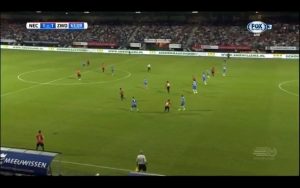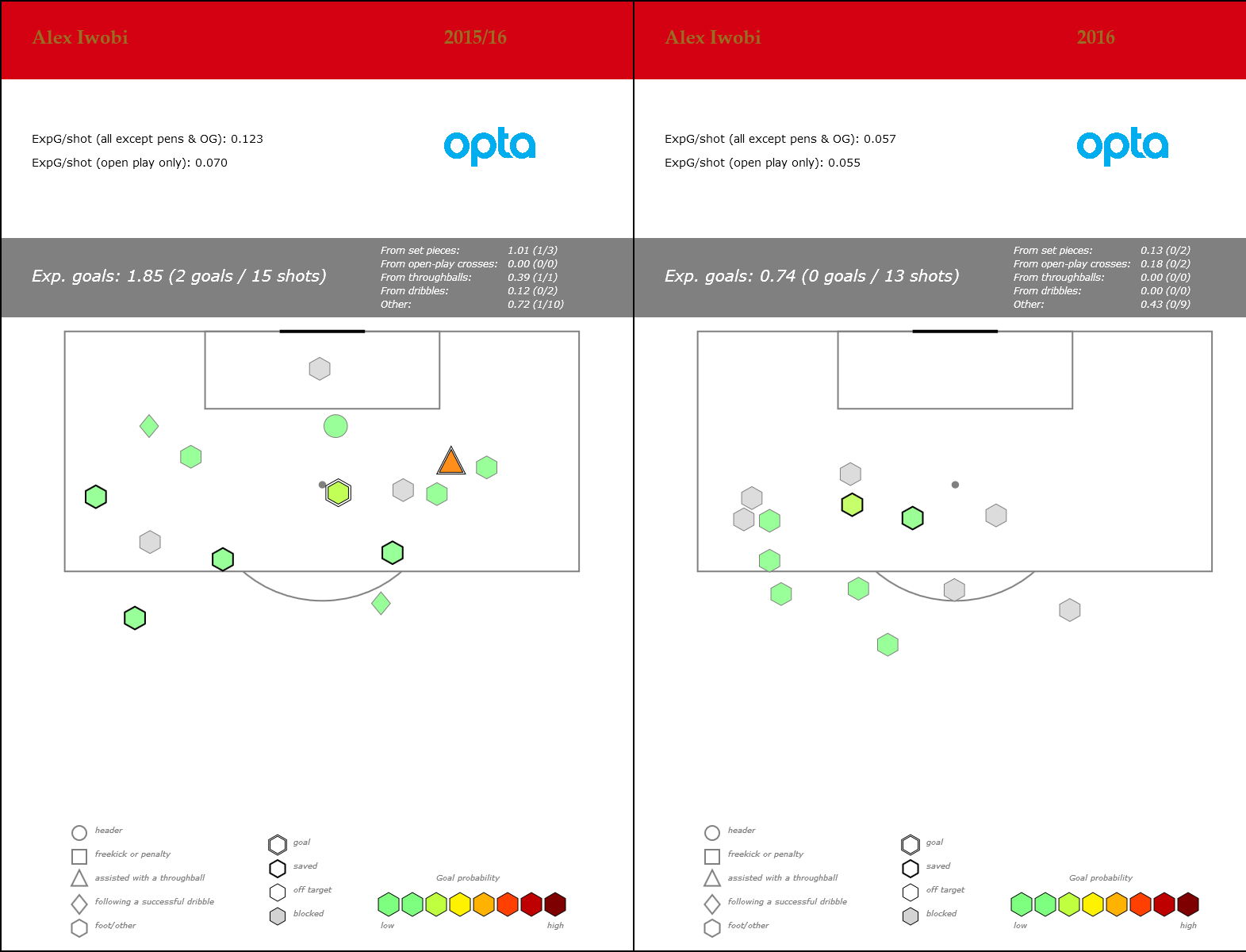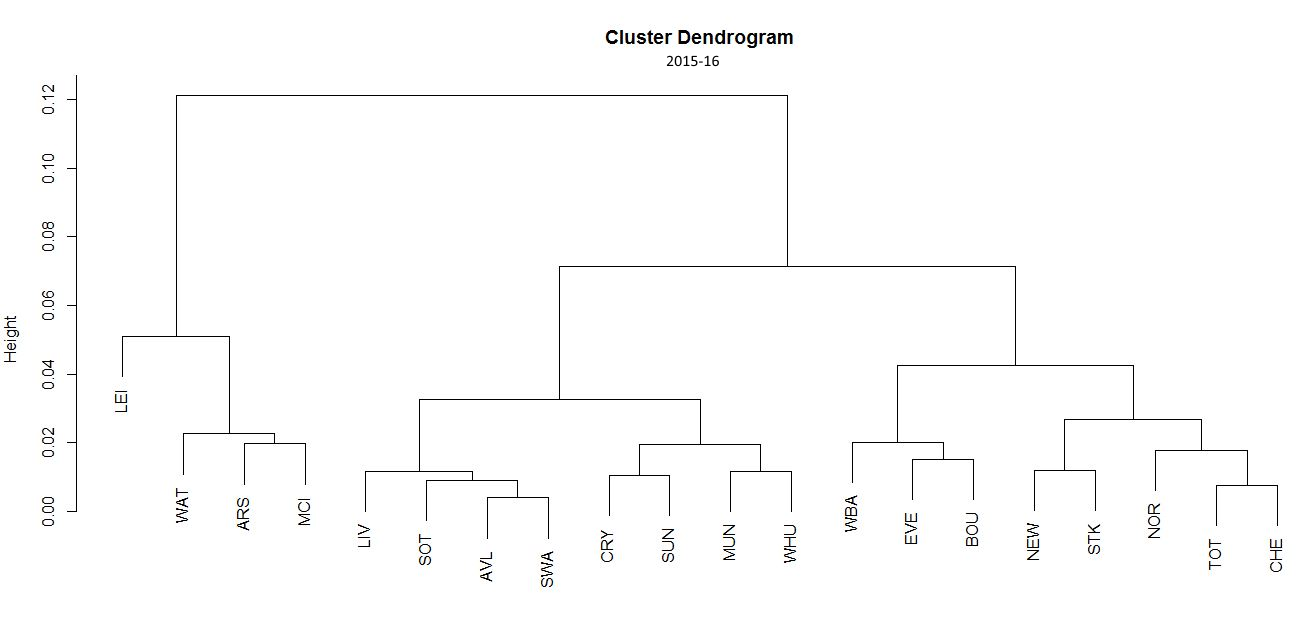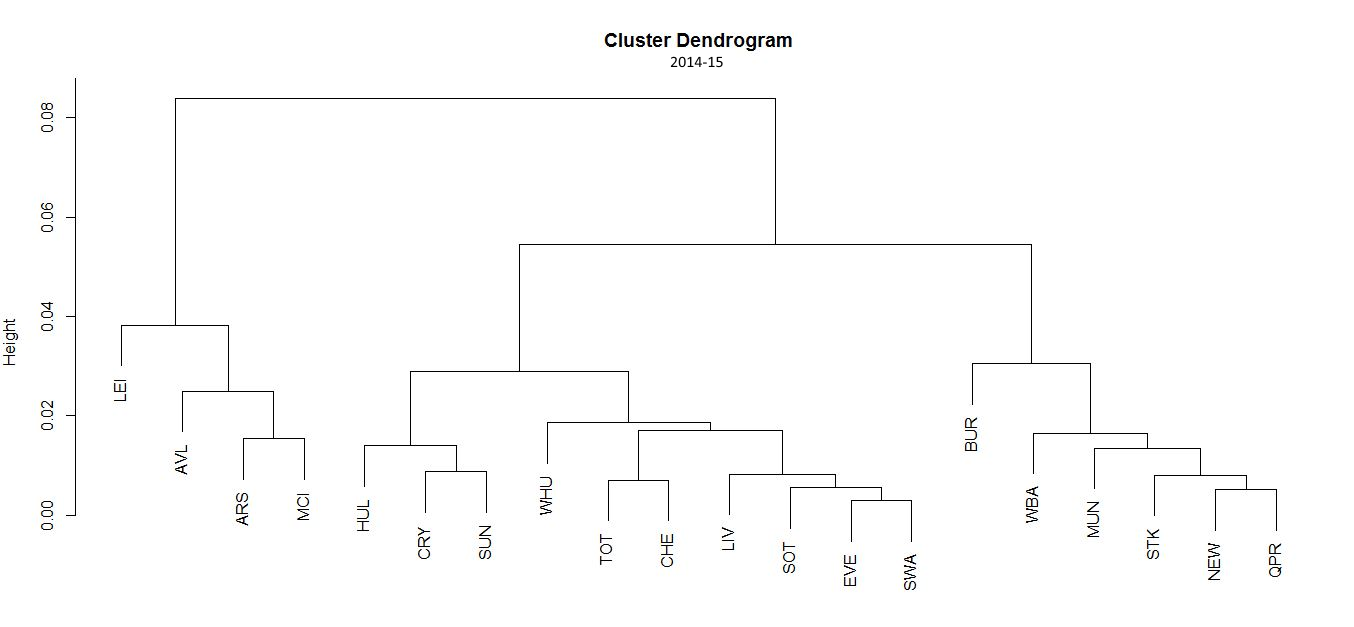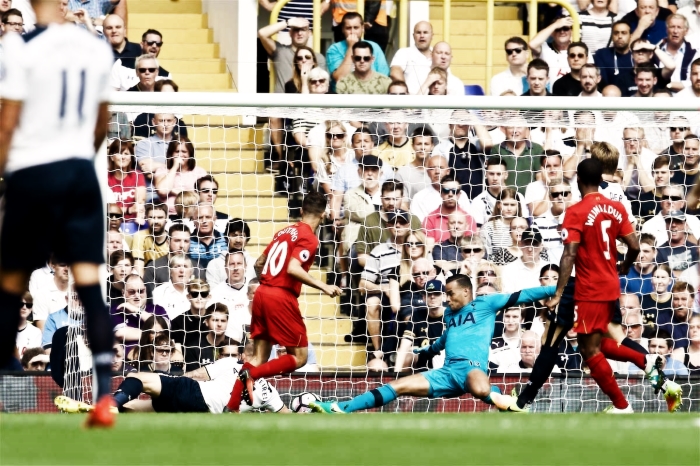 Twelve games have passed in the Premier League and there’s value in looking at comparative historical numbers at various points. It’s a good time to take stock because a) it’s starting to become a vaguely decent sample and b) I have a load of numbers stored at twelve games because i’ve written this before. This is the eighth season of Opta data that has been published publicly around the place and with every season that passes, the more interesting the outliers become. One reflection worth making is that at this point last season, Leicester really weren’t signalling their rise to the top. Sure they had won seven games, sat third, had scored 25 goals and lost just once, but they had also shipped 20 goals. All their shot rates were around par, and understandably given their matches averaging nearly four goals per game, their conversions were high at both ends. That they turned this into 25 points was remarkable and just stage one of the Leicester miracle; indeed all this looked sure to regress over time and see them fall back. Part two of the Leicester miracle indeed saw everything slow down, but the defence stopped conceding, almost entirely for a long spring period, the rest of the league huffed, puffed and blew itself up, and the rest is history. I wrote a couple of weeks ago about their early accuracy problems and that this was just one of the small likely unrepeatable aspects that were likely to regress for Leicester. The early numbers show the dial has moved enormously. Between skill and luck, somewhere Leicester have stopped being able to prevent shots landing on goal and have forgotten how to create them themselves. Their shot numbers were never great last season, but are decidedly poor this year: 10.5 shots per game (137th/160) would make Louis van Gaal proud and 2.8 shots on target per game (148th) would gain favourable glances from Tony Pulis. Over five shots on target conceded is pretty lousy too, and they will need to refocus on the league now their Champions League progression has been secured. Lightning has indeed struck twice, but while the first strike illuminated the sky and brought light where before there was only the darkness of a late night casino, this time it has wreaked only destruction having landed square onto Jamie Vardy’s left foot. Another curio is that their twelve game goals against column reads “20” for both seasons and when they were terrible in 2014/15 it was 18. Half a story, sure, but there we go. “But what of expected goals?” Fret not, there are many ways to look at this but they’re about five goals behind expectation this season having been about twelve ahead of it in the whole of 2015-16. The inputs tell us more, they’ve lost shots and the ones they have been taking have been from an average of around a metre further away. Shots A kindergarten basic chart makes a point here so here you go:
Twelve games have passed in the Premier League and there’s value in looking at comparative historical numbers at various points. It’s a good time to take stock because a) it’s starting to become a vaguely decent sample and b) I have a load of numbers stored at twelve games because i’ve written this before. This is the eighth season of Opta data that has been published publicly around the place and with every season that passes, the more interesting the outliers become. One reflection worth making is that at this point last season, Leicester really weren’t signalling their rise to the top. Sure they had won seven games, sat third, had scored 25 goals and lost just once, but they had also shipped 20 goals. All their shot rates were around par, and understandably given their matches averaging nearly four goals per game, their conversions were high at both ends. That they turned this into 25 points was remarkable and just stage one of the Leicester miracle; indeed all this looked sure to regress over time and see them fall back. Part two of the Leicester miracle indeed saw everything slow down, but the defence stopped conceding, almost entirely for a long spring period, the rest of the league huffed, puffed and blew itself up, and the rest is history. I wrote a couple of weeks ago about their early accuracy problems and that this was just one of the small likely unrepeatable aspects that were likely to regress for Leicester. The early numbers show the dial has moved enormously. Between skill and luck, somewhere Leicester have stopped being able to prevent shots landing on goal and have forgotten how to create them themselves. Their shot numbers were never great last season, but are decidedly poor this year: 10.5 shots per game (137th/160) would make Louis van Gaal proud and 2.8 shots on target per game (148th) would gain favourable glances from Tony Pulis. Over five shots on target conceded is pretty lousy too, and they will need to refocus on the league now their Champions League progression has been secured. Lightning has indeed struck twice, but while the first strike illuminated the sky and brought light where before there was only the darkness of a late night casino, this time it has wreaked only destruction having landed square onto Jamie Vardy’s left foot. Another curio is that their twelve game goals against column reads “20” for both seasons and when they were terrible in 2014/15 it was 18. Half a story, sure, but there we go. “But what of expected goals?” Fret not, there are many ways to look at this but they’re about five goals behind expectation this season having been about twelve ahead of it in the whole of 2015-16. The inputs tell us more, they’ve lost shots and the ones they have been taking have been from an average of around a metre further away. Shots A kindergarten basic chart makes a point here so here you go: 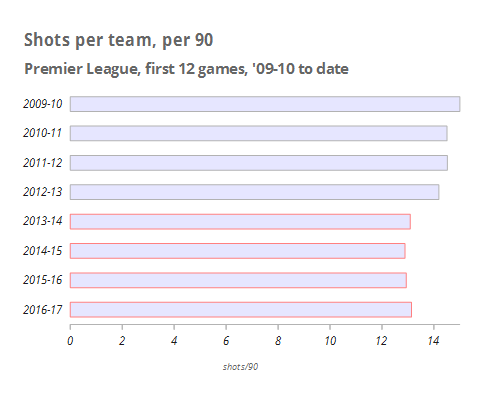 There are fewer shots than there used to be in the near past. It's a point I regularly make, but it makes sense to bear in mind when pondering this stuff. We now have 160 twelve game team season starts (2009-10 to date) to look at so that's how the ranks work when mentioned. Liverpool Everything shots related looks nice for Liverpool. They lead the league for shots with 18.8 per game (9th/160), on target (7.3 per game, 4th), shots against (7.7 per game, 1st) and are in the top 20 for shots on target against too. This plays into average shots of +11.1 per game (2nd) and +4.2 on target (3rd). Of course all these things interrelate, but it's nonetheless pretty impressive stuff and they are deservedly well in the mix for the title. Comparison to 2013-14 is inevitable, but at twelve games then the team was looking good but not great--they were taking around 55% of the shots instead of the 70% they are now--and that title assault was based primarily on a huge middle and latter third where the team absolutely took off on the front end. They've already done that this season and you probably don't like money if you're betting against them based on shooting metrics. While shot volumes like Liverpool a lot more in 2016-17 to 2013-14, there are similarities, ones that feel inevitable. At both ends in both seasons, the shots that are taken and conceded are landing on target at a high volume; this season in attack it's 39% (10th), so good, but in defence it's a huge 41% (2nd worst), while a similarly huge 15% of those shots are going in (6th worst). Weighing this up is tricky because as noted, they are conceding a tiny volume of shots but in terms of preventing the shots they allow to land on target, only Jose Mourinho's Chelsea debacle of 2015-16 exceeds this rate at this point. That sounds scary right? Well, if you're a Liverpool fan hang onto the huge excess in shots, and hope that the the defence doesn't get called to step up at any point. That is of course the key aspect here because if the attack goes through a quiet spell, which it surely will, they might need a few breaks to stay with the pace. The two good Liverpool teams are only a win apart (7-3-2 in 2013-14 to 8-3-1 now) and that lack of divergence given the differences in structural metrics could well be attributed to the 12 game save percentages, this season it is 63%, then it was 78% and only fell later on. When you commit to attack, or rabid counterpressing, there's always a possibility that there will be leaks elsewhere, but it's surely a lot more fun this way? For all that, if you could somehow glue the front third of 2016-17 to the back two thirds of 2013-14, you'd have one hell of a season. Is this a surprise though? Well not really. Season one of Jurgen Klopp involved some excellent shot metrics and then got a little sidetracked by the Europa League run and occasional weird defeats. The potential was there and they have clearly taken a step forward this season with no Europe and a strong starting eleven. I still feel cautious about their ability to field injuries and squad depth, even allowing for fewer games but little of all this will be news to Liverpool fans, who are well served by stat types among their fanbase. They know they're good and are just hoping the train stays on the track. Expected goals? Yep, they like them. A lot. They have a +16 goal difference because they are a expected +16 team. Would finishing top four be enough? As a pragmatic football supporter well able to alienate swathes of fans with sensible takes, building into top four in Klopp's second season would be an excellent achievement and would bode extremely well for the future. Should a title bid fail, it should not be mourned or considered a missed opportunity, unless maybe you've sat on the Kop for 40 years, because then i'm the last person you're going to listen to. Other big shots In isolation, it would be easy to get excited about Liverpool's apparent progress and forget the rest but this year, a polar opposite to last, finds contenders lining up. On the front end, Tottenham, Manchester City, Chelsea, and Manchester United, yes... Manchester United are all creating historically high shot volume without doing anything spectacular, but the intrigue appears when we look at defences. Shots Against, per game Manchester City, 8.5 (5th/160) Chelsea, 8.6 (6th) Manchester United, 9.7 (9th) We also find Tottenham, Arsenal and Southampton in the historic top twenty. So after twelve games, seven of the meanest twenty shot teams over the last eight years are from 2016-17 and this naturally feeds into on target rates too, with Chelsea's 2.2 per game (2nd) and Southampton's 2.5 (4th) particularly notable and Tottenham and Man City pretty close behind. And if we follow this wee journey to it's natural conclusion, we get various combinations of these all teams in a historic top twenty for plus/minus shots and shots on target and good old TSR and SOTR. This season, the good teams are solidly superior (and the bad teams are awful), as this example chart of TSR shows (similar holds across SOTR or xG...):
There are fewer shots than there used to be in the near past. It's a point I regularly make, but it makes sense to bear in mind when pondering this stuff. We now have 160 twelve game team season starts (2009-10 to date) to look at so that's how the ranks work when mentioned. Liverpool Everything shots related looks nice for Liverpool. They lead the league for shots with 18.8 per game (9th/160), on target (7.3 per game, 4th), shots against (7.7 per game, 1st) and are in the top 20 for shots on target against too. This plays into average shots of +11.1 per game (2nd) and +4.2 on target (3rd). Of course all these things interrelate, but it's nonetheless pretty impressive stuff and they are deservedly well in the mix for the title. Comparison to 2013-14 is inevitable, but at twelve games then the team was looking good but not great--they were taking around 55% of the shots instead of the 70% they are now--and that title assault was based primarily on a huge middle and latter third where the team absolutely took off on the front end. They've already done that this season and you probably don't like money if you're betting against them based on shooting metrics. While shot volumes like Liverpool a lot more in 2016-17 to 2013-14, there are similarities, ones that feel inevitable. At both ends in both seasons, the shots that are taken and conceded are landing on target at a high volume; this season in attack it's 39% (10th), so good, but in defence it's a huge 41% (2nd worst), while a similarly huge 15% of those shots are going in (6th worst). Weighing this up is tricky because as noted, they are conceding a tiny volume of shots but in terms of preventing the shots they allow to land on target, only Jose Mourinho's Chelsea debacle of 2015-16 exceeds this rate at this point. That sounds scary right? Well, if you're a Liverpool fan hang onto the huge excess in shots, and hope that the the defence doesn't get called to step up at any point. That is of course the key aspect here because if the attack goes through a quiet spell, which it surely will, they might need a few breaks to stay with the pace. The two good Liverpool teams are only a win apart (7-3-2 in 2013-14 to 8-3-1 now) and that lack of divergence given the differences in structural metrics could well be attributed to the 12 game save percentages, this season it is 63%, then it was 78% and only fell later on. When you commit to attack, or rabid counterpressing, there's always a possibility that there will be leaks elsewhere, but it's surely a lot more fun this way? For all that, if you could somehow glue the front third of 2016-17 to the back two thirds of 2013-14, you'd have one hell of a season. Is this a surprise though? Well not really. Season one of Jurgen Klopp involved some excellent shot metrics and then got a little sidetracked by the Europa League run and occasional weird defeats. The potential was there and they have clearly taken a step forward this season with no Europe and a strong starting eleven. I still feel cautious about their ability to field injuries and squad depth, even allowing for fewer games but little of all this will be news to Liverpool fans, who are well served by stat types among their fanbase. They know they're good and are just hoping the train stays on the track. Expected goals? Yep, they like them. A lot. They have a +16 goal difference because they are a expected +16 team. Would finishing top four be enough? As a pragmatic football supporter well able to alienate swathes of fans with sensible takes, building into top four in Klopp's second season would be an excellent achievement and would bode extremely well for the future. Should a title bid fail, it should not be mourned or considered a missed opportunity, unless maybe you've sat on the Kop for 40 years, because then i'm the last person you're going to listen to. Other big shots In isolation, it would be easy to get excited about Liverpool's apparent progress and forget the rest but this year, a polar opposite to last, finds contenders lining up. On the front end, Tottenham, Manchester City, Chelsea, and Manchester United, yes... Manchester United are all creating historically high shot volume without doing anything spectacular, but the intrigue appears when we look at defences. Shots Against, per game Manchester City, 8.5 (5th/160) Chelsea, 8.6 (6th) Manchester United, 9.7 (9th) We also find Tottenham, Arsenal and Southampton in the historic top twenty. So after twelve games, seven of the meanest twenty shot teams over the last eight years are from 2016-17 and this naturally feeds into on target rates too, with Chelsea's 2.2 per game (2nd) and Southampton's 2.5 (4th) particularly notable and Tottenham and Man City pretty close behind. And if we follow this wee journey to it's natural conclusion, we get various combinations of these all teams in a historic top twenty for plus/minus shots and shots on target and good old TSR and SOTR. This season, the good teams are solidly superior (and the bad teams are awful), as this example chart of TSR shows (similar holds across SOTR or xG...): 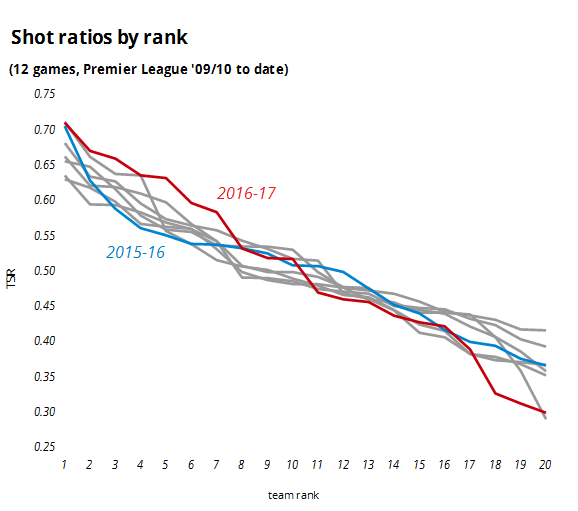 Any thoughts on a rise of the middle class are long gone here, and the bounce back from the better teams has been extreme. The "no Europe" theories around Liverpool and Chelsea must count for something, as it has freed up their schedules but Man Utd once more have an attack under Mourinho after ending up a ten shot team under van Gaal. Also, Pep Guardiola has maintained Man City's strong structure in the numbers (lest we forget this time last year they were looking superb on the numbers). Claude Puel has created an odd mix of solid volume but weird conversions at Southampton, Mauricio Pochettino is as ever the same at Tottenham and Arsenal appear to be continuing their quest towards quality over volume. The current top five, and even Manchester United are all staring at potential top four chances, and while this far out it's too soon to be making concrete predictions of how it will shape up, 12 games in, (just about) six still vie to become four, and we are looking at a genuine deep and exciting title run. Tottenham So wait, what was that just there? Tottenham are the same as ever? What does that mean? Slew of injuries to key men. Odd transfers in the summer. Trouble creating chances. Champions League failure. All off the back of last season's impressive work. It's a tough life being unbeaten in the league. So what gives? All is similar, at least according to this raft of old-school numbers and also in a bigger sample, given how broadly comparable this first twelve games are to the entirety of 2015-16:
Any thoughts on a rise of the middle class are long gone here, and the bounce back from the better teams has been extreme. The "no Europe" theories around Liverpool and Chelsea must count for something, as it has freed up their schedules but Man Utd once more have an attack under Mourinho after ending up a ten shot team under van Gaal. Also, Pep Guardiola has maintained Man City's strong structure in the numbers (lest we forget this time last year they were looking superb on the numbers). Claude Puel has created an odd mix of solid volume but weird conversions at Southampton, Mauricio Pochettino is as ever the same at Tottenham and Arsenal appear to be continuing their quest towards quality over volume. The current top five, and even Manchester United are all staring at potential top four chances, and while this far out it's too soon to be making concrete predictions of how it will shape up, 12 games in, (just about) six still vie to become four, and we are looking at a genuine deep and exciting title run. Tottenham So wait, what was that just there? Tottenham are the same as ever? What does that mean? Slew of injuries to key men. Odd transfers in the summer. Trouble creating chances. Champions League failure. All off the back of last season's impressive work. It's a tough life being unbeaten in the league. So what gives? All is similar, at least according to this raft of old-school numbers and also in a bigger sample, given how broadly comparable this first twelve games are to the entirety of 2015-16: 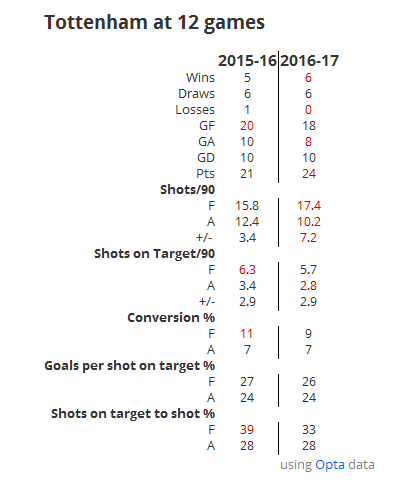 We can also look quickly at expected goals, and Tottenham are at around +0.49 per game this year compared to +0.54 last year. Recall, expected goals did not translate Tottenham's shot volumes happily then and disregards them similarly now, primarily because they shoot from anywhere and everywhere and are not focused on building better, closer chances. That's still the plan, but this year they are back towards normal in their accuracy rate, for all that in reality, it has cost them just two goals. It's sacrilege to say that aspects of this team--or at least the way it creates some of its outputs--are intriguingly similar to those that Andre Villas Boas devised, so I will not make that comparison. Bad teams One of the refreshing things about how statistical and analytical ideas are starting to spread and become understood is that I feel i've seen widespread dismissal in my echo chamber of Burnley and Hull as Premier League quality teams, despite a slew of good early results. Swansea sit rock bottom with just six points, primarily due to moderate-to-bad numbers and horrible conversion rates, and do face a genuine battle to recover but with Sunderland bad but slightly odd and the aforementioned pair in the league, must retain hope. Expected goals has them 17th with an attack-free nine shot per game Middlesbrough in hailing distance, and it seems likely that it's three from five for the drop provided Alan Pardew doesn't contrive to continue his amazingly poor run of 2016 results. Let's line this up: Hull and Burnley are objectively and historically terrible Premier League teams and Sunderland are not far behind them. Firstly defence: Hull and Burnley are conceding more than twenty shots a game which ranks them worst and second worst in the sample, and the only two teams to exceed that mark.. Sunderland are conceding 18.8 per game eighth worst and each of these three is allowing over six shots on target per game and lands among the ten worst teams out of 160, with Burnley the single worst (6.8 per game). Attack? Burnley are creating shots at a rate of 8.7 per game with 2.3 on target, enough for second and third worst rankings while Hull and Sunderland also inhabit various bottom five, ten or twenty positions. These three teams are in the bottom four for the entire sample for all combination shot metrics (+/-, TSR, SOTR) with Burnley's shot on target ratio a truly staggering 25% and a full five percent lower than any other team. Remember the bad teams? Cardiff 2013-14, Portsmouth 2009-10, Reading 2012-13 or Aston Villa 2015-16... all of whom put up better numbers than this sorry lot at this stage of the season. Poor Tom Heaton is making more saves than any other goalkeeper has this decade. He has rightly earned plaudits but has faced no choice. Expected goals is happy to join in and while the only team to go a season with more than a minus one per game expected goal difference is Reading 2012-13, both Burnley and Hull are exceeding this mark. Yet by virtue of the Heaton heroics and a positive skew at both ends--at least until they were trounced 4-0 at West Brom--Burnley are sitting in a hollow and fragile 12th, almost certainly doomed to fall, with only those points already accrued to use as a parachute and potentially spare their demise. Huge improvement is required to stop them falling towards the trap door, as it is for Hull who simply seem overmatched and ill prepared for the league. To at least some degree, the good teams seem better this year and have happily beaten up the bad teams, and this is reflected here. Sunderland defy explanation year after year by surviving with terrible metrics. What more can be said? Curios
We can also look quickly at expected goals, and Tottenham are at around +0.49 per game this year compared to +0.54 last year. Recall, expected goals did not translate Tottenham's shot volumes happily then and disregards them similarly now, primarily because they shoot from anywhere and everywhere and are not focused on building better, closer chances. That's still the plan, but this year they are back towards normal in their accuracy rate, for all that in reality, it has cost them just two goals. It's sacrilege to say that aspects of this team--or at least the way it creates some of its outputs--are intriguingly similar to those that Andre Villas Boas devised, so I will not make that comparison. Bad teams One of the refreshing things about how statistical and analytical ideas are starting to spread and become understood is that I feel i've seen widespread dismissal in my echo chamber of Burnley and Hull as Premier League quality teams, despite a slew of good early results. Swansea sit rock bottom with just six points, primarily due to moderate-to-bad numbers and horrible conversion rates, and do face a genuine battle to recover but with Sunderland bad but slightly odd and the aforementioned pair in the league, must retain hope. Expected goals has them 17th with an attack-free nine shot per game Middlesbrough in hailing distance, and it seems likely that it's three from five for the drop provided Alan Pardew doesn't contrive to continue his amazingly poor run of 2016 results. Let's line this up: Hull and Burnley are objectively and historically terrible Premier League teams and Sunderland are not far behind them. Firstly defence: Hull and Burnley are conceding more than twenty shots a game which ranks them worst and second worst in the sample, and the only two teams to exceed that mark.. Sunderland are conceding 18.8 per game eighth worst and each of these three is allowing over six shots on target per game and lands among the ten worst teams out of 160, with Burnley the single worst (6.8 per game). Attack? Burnley are creating shots at a rate of 8.7 per game with 2.3 on target, enough for second and third worst rankings while Hull and Sunderland also inhabit various bottom five, ten or twenty positions. These three teams are in the bottom four for the entire sample for all combination shot metrics (+/-, TSR, SOTR) with Burnley's shot on target ratio a truly staggering 25% and a full five percent lower than any other team. Remember the bad teams? Cardiff 2013-14, Portsmouth 2009-10, Reading 2012-13 or Aston Villa 2015-16... all of whom put up better numbers than this sorry lot at this stage of the season. Poor Tom Heaton is making more saves than any other goalkeeper has this decade. He has rightly earned plaudits but has faced no choice. Expected goals is happy to join in and while the only team to go a season with more than a minus one per game expected goal difference is Reading 2012-13, both Burnley and Hull are exceeding this mark. Yet by virtue of the Heaton heroics and a positive skew at both ends--at least until they were trounced 4-0 at West Brom--Burnley are sitting in a hollow and fragile 12th, almost certainly doomed to fall, with only those points already accrued to use as a parachute and potentially spare their demise. Huge improvement is required to stop them falling towards the trap door, as it is for Hull who simply seem overmatched and ill prepared for the league. To at least some degree, the good teams seem better this year and have happily beaten up the bad teams, and this is reflected here. Sunderland defy explanation year after year by surviving with terrible metrics. What more can be said? Curios
- The difference between West Ham's rate of of getting their shots on target (20%) compared to their opposition (40%) is five percentage points higher than another team in the sample. Aston Villa's gutter ball streak 2015-16 is the worst full season here (-9%) so to be over twice as bad at 12 games is both horrific and surely prime for reversion.
- There are no historically high or low save percentages thus far.
- Our old friend PDO, still a cracking ready reckoner at this stage, sees Southampton 3rd worst after 12 at 0.79, and Swansea at 6th at 0.84. Arsenal and Burnley are both at 1.16 and high. These numbers may or may not move towards 1.00.
- Everton's rate of landing their shots on target compared to their opposition is extremely high (+12 percentage points, =2nd). The two teams ranked first here and tied second are Southampton 2014-15 and 2015-16. So: of 160 twelve game season starts, the three highest scores by this metric are the only three Ronald Koeman teams in the sample. This would be a lot more powerful if it held through the season, but it hasn't and Southampton regressed in both seasons here. But it's nonetheless the most curious of the curios.
________________________________________________ Thanks for reading @jair1970
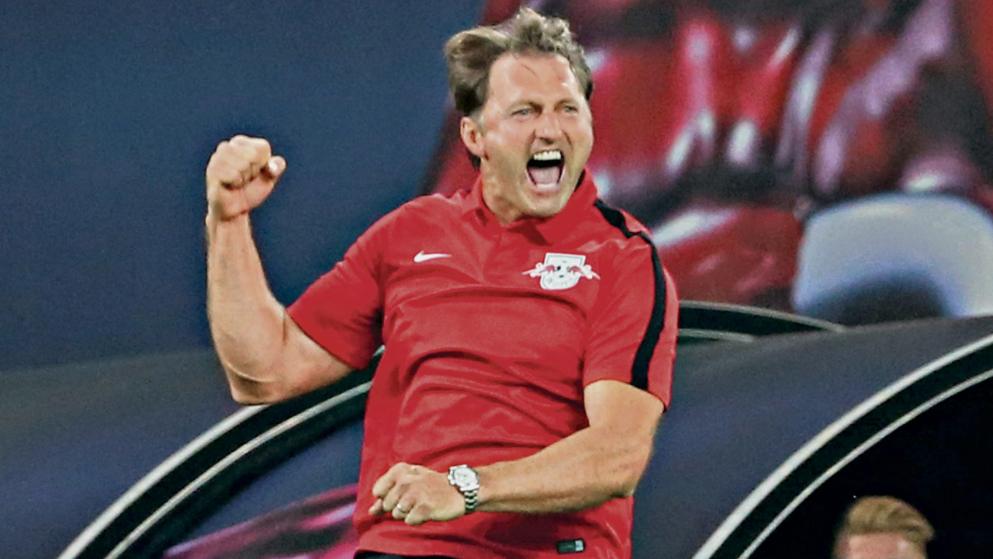
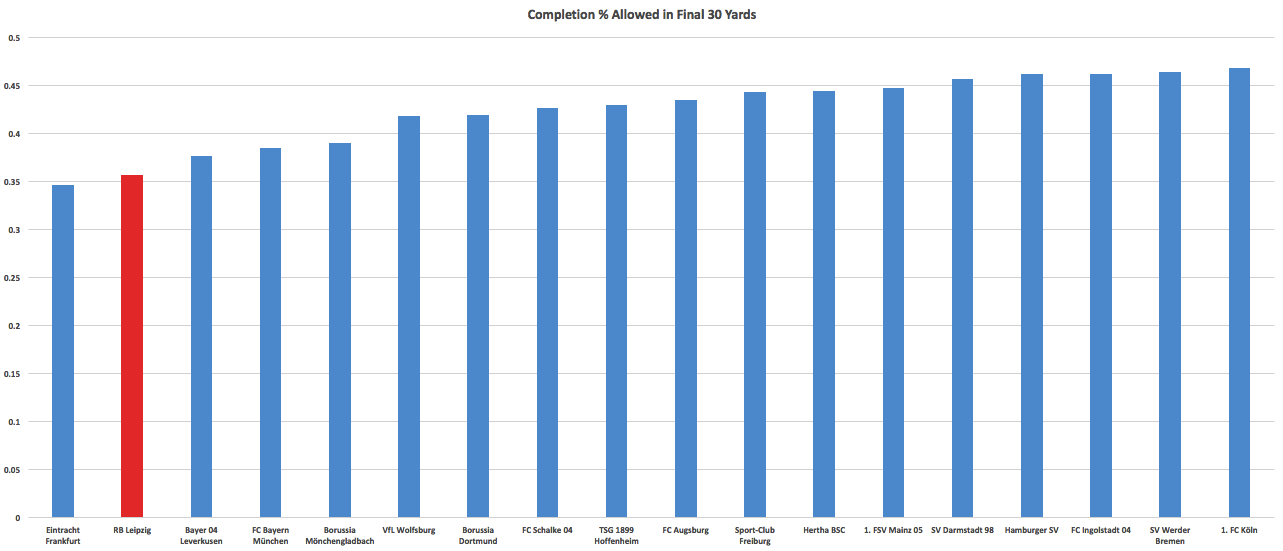
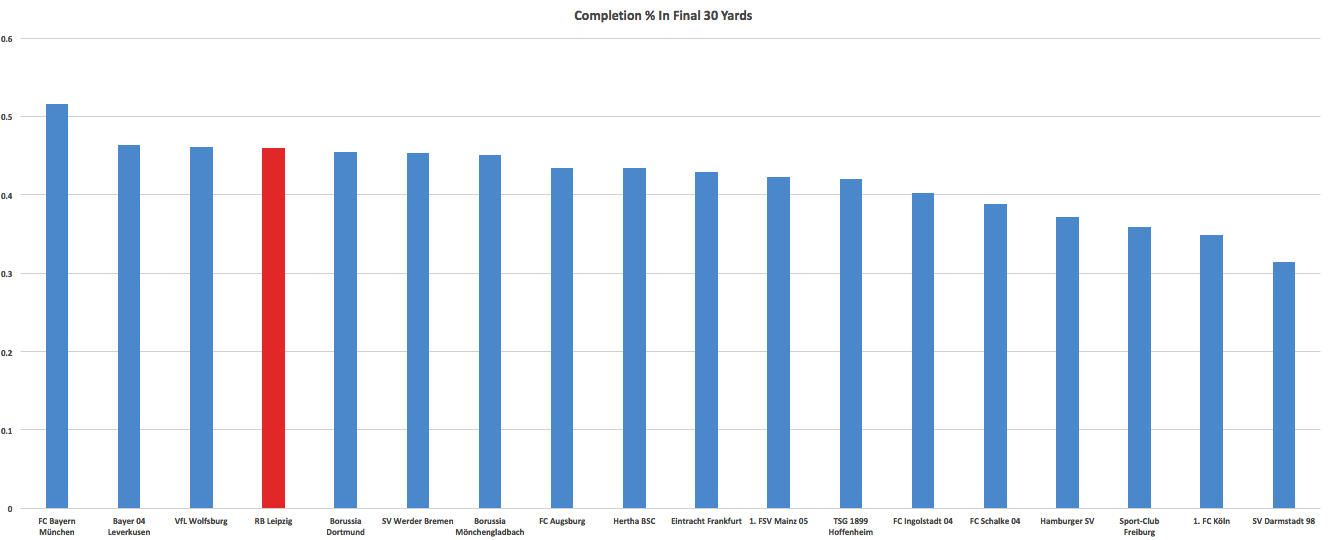 This has been a team effort but I want to highlight two players in particular who have caught my eye and then one I kind of scratch my head about and wonder if it's a bit of a leak. Naby Keita
This has been a team effort but I want to highlight two players in particular who have caught my eye and then one I kind of scratch my head about and wonder if it's a bit of a leak. Naby Keita 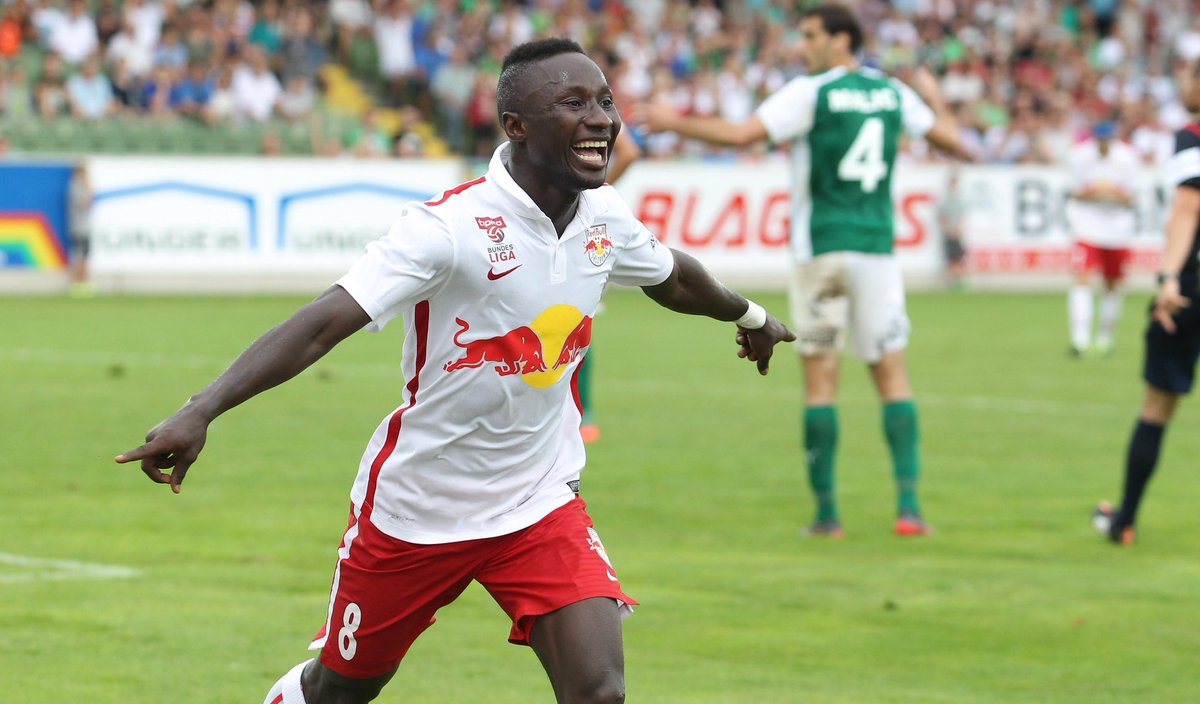 12 players on Leipzig have played more minutes than the 21 year old but he pops up in their top 3 at both moving the ball from midfield toward the fringes of the danger zone (
12 players on Leipzig have played more minutes than the 21 year old but he pops up in their top 3 at both moving the ball from midfield toward the fringes of the danger zone (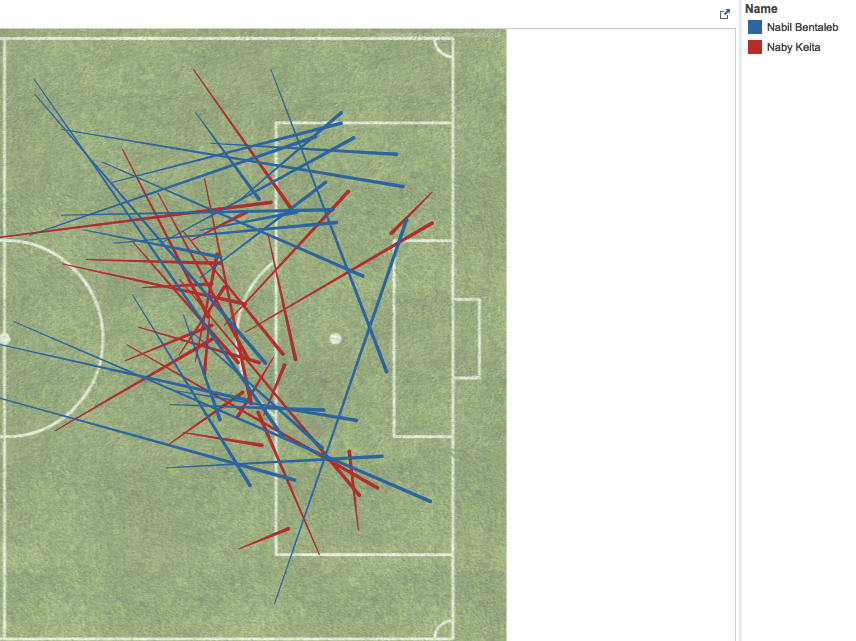 No player who is among the top 3 on their team plays shorter entry passes than Keita's at 19.7 yards. The only players with a higher entry pass completion % are his teammate Marcel Halstenberg and Wolfsburg superstar Julian Draxler. Basically when
No player who is among the top 3 on their team plays shorter entry passes than Keita's at 19.7 yards. The only players with a higher entry pass completion % are his teammate Marcel Halstenberg and Wolfsburg superstar Julian Draxler. Basically when 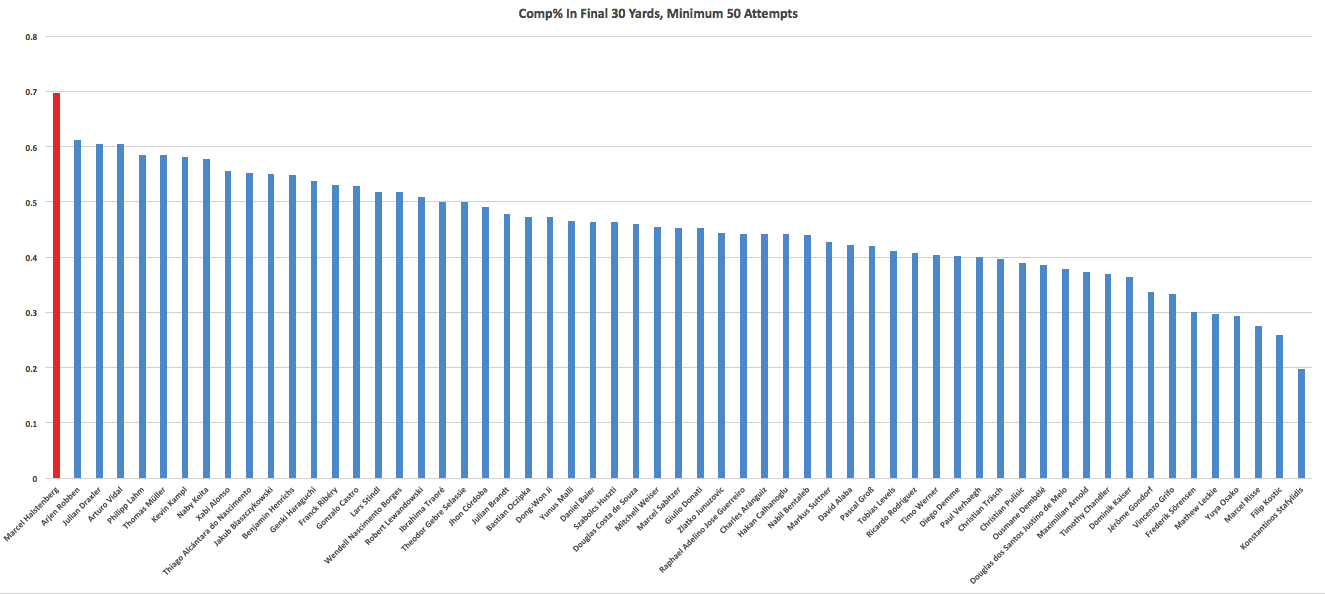 Top 10: Halstenberg, Robben, Draxler, Vidal, Lahm, Müller, Kampl, Keita, Alonso, Thiago. Such a standout stat needs recognition. A Leak? In poker parlance a leak is a consistent weakness or poor strategy in your game that limits you over time. I suspect that having Diego Demme as your main ball-handler might be a leak that could hamper Leipzig's title chase. No Leipzig player averages more passes than Demme's 64, but he is among the worst in the league at advancing the ball into attacking positions. He tries lots of long balls toward the box, and they don't turn many into key passes.
Top 10: Halstenberg, Robben, Draxler, Vidal, Lahm, Müller, Kampl, Keita, Alonso, Thiago. Such a standout stat needs recognition. A Leak? In poker parlance a leak is a consistent weakness or poor strategy in your game that limits you over time. I suspect that having Diego Demme as your main ball-handler might be a leak that could hamper Leipzig's title chase. No Leipzig player averages more passes than Demme's 64, but he is among the worst in the league at advancing the ball into attacking positions. He tries lots of long balls toward the box, and they don't turn many into key passes. 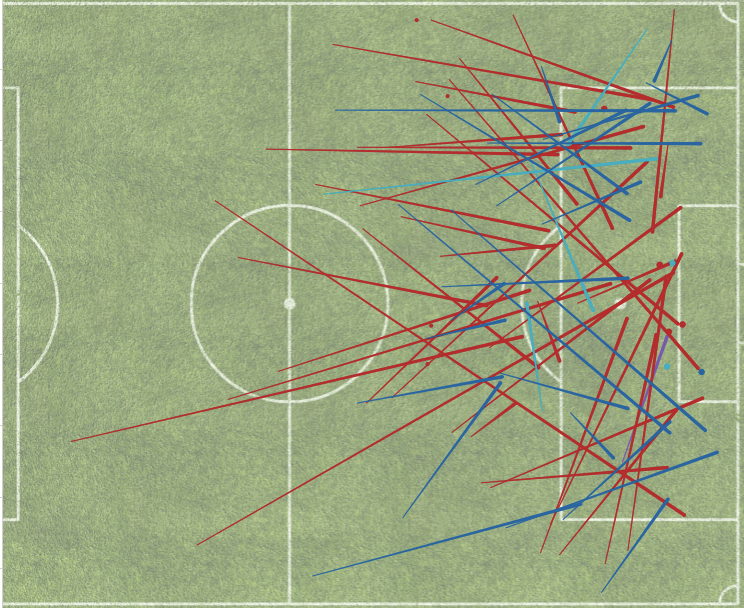 I understand a lot of Leipzig's strategy is based on quick forward passes but this still looks like one of their worst passers is playing the most passes on the team, including the most danger zone entries. He seems to be a good defender and he plays in midfield so you can't just avoid him, but a strategy adjustment I'd like is more Halstenberg and less Demme with the ball. Other Early Standouts Nadiem Amiri has only played 390 minutes so that might keep me from going completely head over heels for him but the motion has begun. Last year
I understand a lot of Leipzig's strategy is based on quick forward passes but this still looks like one of their worst passers is playing the most passes on the team, including the most danger zone entries. He seems to be a good defender and he plays in midfield so you can't just avoid him, but a strategy adjustment I'd like is more Halstenberg and less Demme with the ball. Other Early Standouts Nadiem Amiri has only played 390 minutes so that might keep me from going completely head over heels for him but the motion has begun. Last year 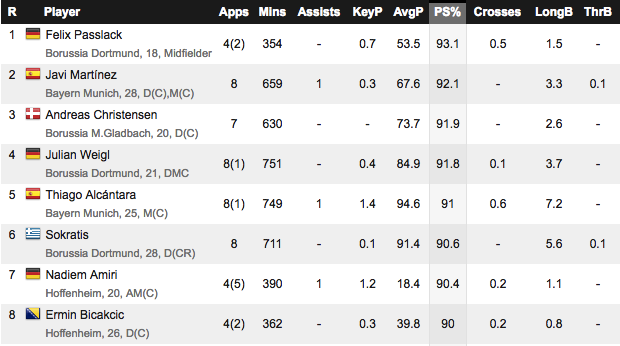 If not for Naby Keita, Kevin Kampl might be the standout midfielder in the early going. He has built on a strong season from last year and has taken on more responsibility after Bellarabi's injury. Only Pascal Groß, Mr. Volume himself, has played more entry passes into the danger zone than Kampl and he's been by far Leverkusen's most reliable and effective option to progress the ball. Fellow midfielder Charles Aranguiz has not quite been able to match Kampl's dynamism or efficiency and the midfield Schmidt was dreaming of has not come fully together. Kampl has been great however, as Leverkusen have dominated territory in a way they never previously have. Too bad that's the only thing they are dominating. Other Early Leaks
If not for Naby Keita, Kevin Kampl might be the standout midfielder in the early going. He has built on a strong season from last year and has taken on more responsibility after Bellarabi's injury. Only Pascal Groß, Mr. Volume himself, has played more entry passes into the danger zone than Kampl and he's been by far Leverkusen's most reliable and effective option to progress the ball. Fellow midfielder Charles Aranguiz has not quite been able to match Kampl's dynamism or efficiency and the midfield Schmidt was dreaming of has not come fully together. Kampl has been great however, as Leverkusen have dominated territory in a way they never previously have. Too bad that's the only thing they are dominating. Other Early Leaks 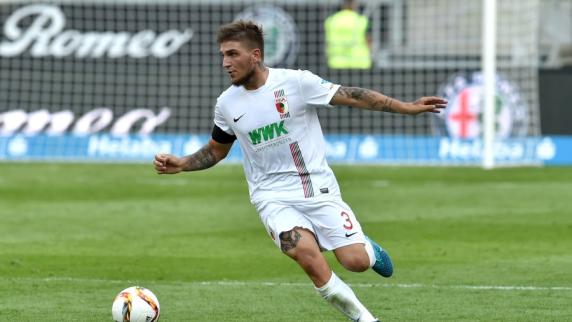
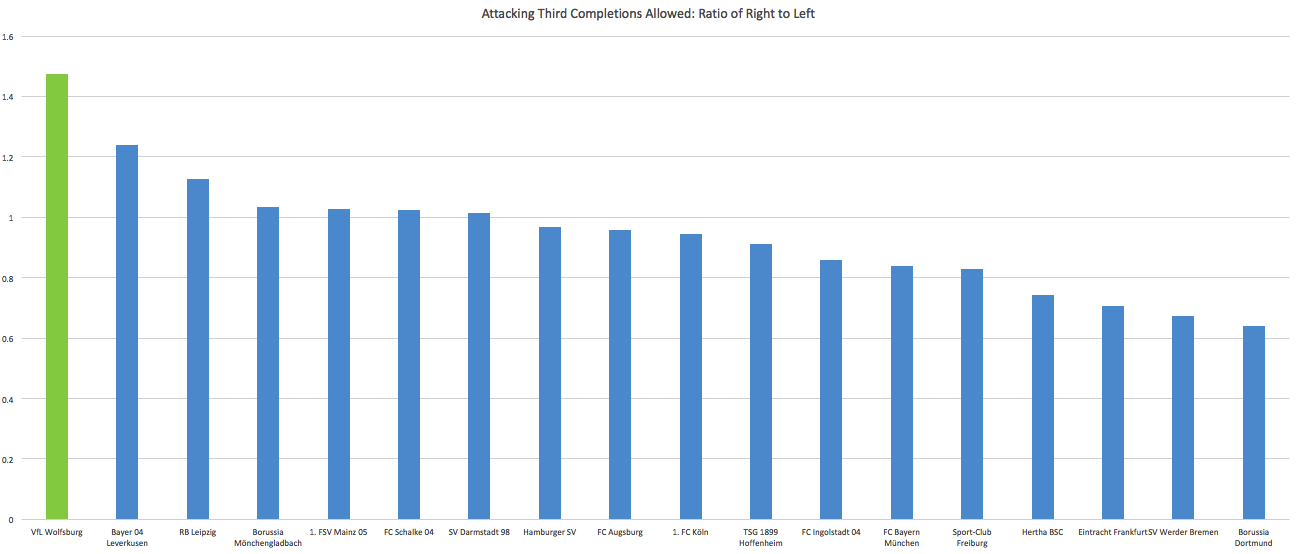 In buildup, opponents move forward more often down the right side.
In buildup, opponents move forward more often down the right side.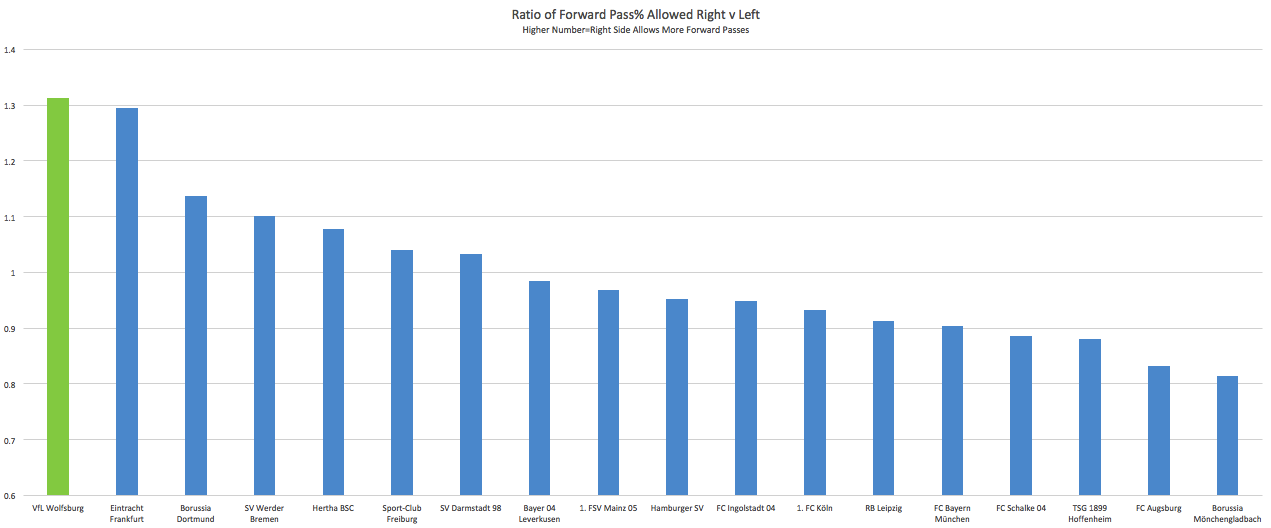 And are more successful moving down the right than the left.
And are more successful moving down the right than the left. 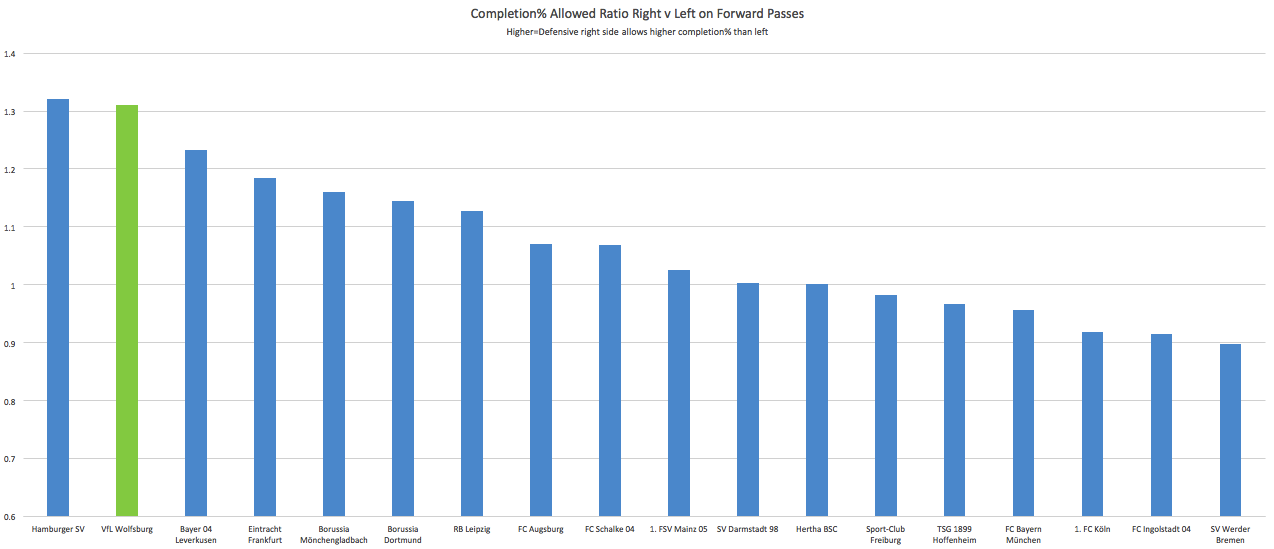 Now is being so lopsided automatically bad? Because the VW braintrust can point to their chances allowed and say they aren't coming overwhelmingly from the right side and that when they do testing in the lab their right side performs exactly like the left. We can tell them that beating a test in a lab is one thing and real life another, but they might have a point on chances created. Maybe it's not automatically bad to have one side be so much softer and targeted much more, but it's something the new manager Valérien Ismaël should be keeping an eye on. Christian Träsch, Kuba, and Vieirinha love getting forward but maybe they don't love getting back or defending enough. One last example, from the Leverkusen game which shows the ease with which Leverkusen move the ball down, around, and toward goal on Wolfsburg's right side. This weekend get ready for Leverkusen v Leipzig, Gladbach v Köln and Dortmund v Bayern in one of the best schedules of the year. Any questions, comments, or qualms you have post a comment here or get at me on twitter @Saturdayoncouch. Hope you enjoyed and enjoy the games this weekend!
Now is being so lopsided automatically bad? Because the VW braintrust can point to their chances allowed and say they aren't coming overwhelmingly from the right side and that when they do testing in the lab their right side performs exactly like the left. We can tell them that beating a test in a lab is one thing and real life another, but they might have a point on chances created. Maybe it's not automatically bad to have one side be so much softer and targeted much more, but it's something the new manager Valérien Ismaël should be keeping an eye on. Christian Träsch, Kuba, and Vieirinha love getting forward but maybe they don't love getting back or defending enough. One last example, from the Leverkusen game which shows the ease with which Leverkusen move the ball down, around, and toward goal on Wolfsburg's right side. This weekend get ready for Leverkusen v Leipzig, Gladbach v Köln and Dortmund v Bayern in one of the best schedules of the year. Any questions, comments, or qualms you have post a comment here or get at me on twitter @Saturdayoncouch. Hope you enjoyed and enjoy the games this weekend!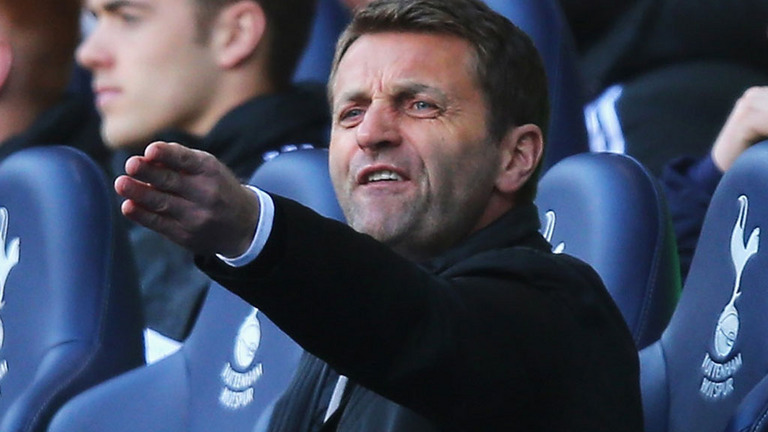
 Great question, and one whose answer may decide the title this season. They are awesome at constraining opposing shots, giving up less than 8 a game, and way out there in terms of performance among top teams. This is huge. On the other hand, the quality of shot they do give up is in the bottom 5%. This is an issue with aggressive pressing systems. Break the press, get good shots. Save the cheerleader, save the world. You know how it goes. It's interesting to compare this to Conte's Chelsea, who also only offer up about 8 shots a game, but manage to keep the quality of shots against them below average. One thing I found interesting is that their PPDA (passes per defensive action) isn't at elite levels yet, which to me indicates the press still isn't perfect for various reasons. Anyway, the combined math means Liverpool are good, not great in defense coming in at just under a goal a game in xG. I think in open play, Liverpool might actually be elite (though they could still use a mobile DM for harder games), but their set piece defense has issues. The two questions that come out of this are
Great question, and one whose answer may decide the title this season. They are awesome at constraining opposing shots, giving up less than 8 a game, and way out there in terms of performance among top teams. This is huge. On the other hand, the quality of shot they do give up is in the bottom 5%. This is an issue with aggressive pressing systems. Break the press, get good shots. Save the cheerleader, save the world. You know how it goes. It's interesting to compare this to Conte's Chelsea, who also only offer up about 8 shots a game, but manage to keep the quality of shots against them below average. One thing I found interesting is that their PPDA (passes per defensive action) isn't at elite levels yet, which to me indicates the press still isn't perfect for various reasons. Anyway, the combined math means Liverpool are good, not great in defense coming in at just under a goal a game in xG. I think in open play, Liverpool might actually be elite (though they could still use a mobile DM for harder games), but their set piece defense has issues. The two questions that come out of this are  Do you live in a deeply religious, judgemental country? If so, they might deem your love for another man - even a left back as fine as Nacho Monreal - to be wrong. This, mon frere, is a judgement free zone, so you do you. Ha, who am I kidding? We judge things all the time! It's practically the purpose of the site. That said, we are totally cool with man love and it's fair to say you are with friends. Back to Monreal's quality as a left back, he has been one of the better defending left backs in the Premier League for quite a while. An excellent game reader, he's also been quite good in the air. On the other hand, he doesn't bring that much to the attack, but that isn't really his job. About 18 months ago, we were looking at Arsenal on a new defensive activity vis we'd designed and there was a very clear high intensity spot out on the left wing. @StatLurker dubbed in the "Nacho Monreal Zone of Death." I just smiled.
Do you live in a deeply religious, judgemental country? If so, they might deem your love for another man - even a left back as fine as Nacho Monreal - to be wrong. This, mon frere, is a judgement free zone, so you do you. Ha, who am I kidding? We judge things all the time! It's practically the purpose of the site. That said, we are totally cool with man love and it's fair to say you are with friends. Back to Monreal's quality as a left back, he has been one of the better defending left backs in the Premier League for quite a while. An excellent game reader, he's also been quite good in the air. On the other hand, he doesn't bring that much to the attack, but that isn't really his job. About 18 months ago, we were looking at Arsenal on a new defensive activity vis we'd designed and there was a very clear high intensity spot out on the left wing. @StatLurker dubbed in the "Nacho Monreal Zone of Death." I just smiled.  They say game recognize game, and I don't think Leipzig really need me. They have an amazing player development pipeline, a great coach, and their Director of Football Ralf Rangnick has so many edges figured out, his team has gone from promotion to the top of the Bundesliga in no time flat. It's possible their external recruitment could get a touch better using our tool set and methodology, but I'm not even sure of that. They execute extremely well. Top 5 Bundesliga Coaches (no order): Tuchel Hassenhutl Ancelotti Schmidt Nagelsmann Craft beer is complicated because availability across countries is miserable. The Reservoir Dogs line from
They say game recognize game, and I don't think Leipzig really need me. They have an amazing player development pipeline, a great coach, and their Director of Football Ralf Rangnick has so many edges figured out, his team has gone from promotion to the top of the Bundesliga in no time flat. It's possible their external recruitment could get a touch better using our tool set and methodology, but I'm not even sure of that. They execute extremely well. Top 5 Bundesliga Coaches (no order): Tuchel Hassenhutl Ancelotti Schmidt Nagelsmann Craft beer is complicated because availability across countries is miserable. The Reservoir Dogs line from  My mind on this changes practically every week. I could/should finish the book and publish, but in order for it to be as good as I want it to be, I'd have to write about all sorts of edges that are not public right now. That means giving away at least some future utility if I were to go back inside a club, which isn't a particularly comfortable thing. On the other hand, it might be years (or never) until I work completely inside a club or set of clubs again, which is why you see me publishing single chapters from time to time. It's not really a coaching book though, it's just a book that explains how I think about football and why I have come to those conclusions. The hacks from the coaching article this week (
My mind on this changes practically every week. I could/should finish the book and publish, but in order for it to be as good as I want it to be, I'd have to write about all sorts of edges that are not public right now. That means giving away at least some future utility if I were to go back inside a club, which isn't a particularly comfortable thing. On the other hand, it might be years (or never) until I work completely inside a club or set of clubs again, which is why you see me publishing single chapters from time to time. It's not really a coaching book though, it's just a book that explains how I think about football and why I have come to those conclusions. The hacks from the coaching article this week ( At the risk of pissing off an entire profession, I don't understand the purpose of the performance analysis degree. It's not sports science. It's not stats and data. It's not medical. It doesn't often entail programming. And yet people often get a Master's degree in it. ¯\_(ツ)_/¯ I didn't grow up here, so it might be a cultural thing, but having been around football clubs for a number of years now, I genuinely don't understand it as a degree you would spend years at university to learn.
At the risk of pissing off an entire profession, I don't understand the purpose of the performance analysis degree. It's not sports science. It's not stats and data. It's not medical. It doesn't often entail programming. And yet people often get a Master's degree in it. ¯\_(ツ)_/¯ I didn't grow up here, so it might be a cultural thing, but having been around football clubs for a number of years now, I genuinely don't understand it as a degree you would spend years at university to learn.  Just a touch below that right now, but definitely top 20. The question is how many concessions your style of play has to make in order to accommodate his weaknesses. He's been great this year, and this is probably his true level going forward. Fun fact: Did you know Lukaku is completing more than 2 successful dribbles a game? Given his size, this should be physically impossible. How can a man that big and explosive also be... nimble?
Just a touch below that right now, but definitely top 20. The question is how many concessions your style of play has to make in order to accommodate his weaknesses. He's been great this year, and this is probably his true level going forward. Fun fact: Did you know Lukaku is completing more than 2 successful dribbles a game? Given his size, this should be physically impossible. How can a man that big and explosive also be... nimble? 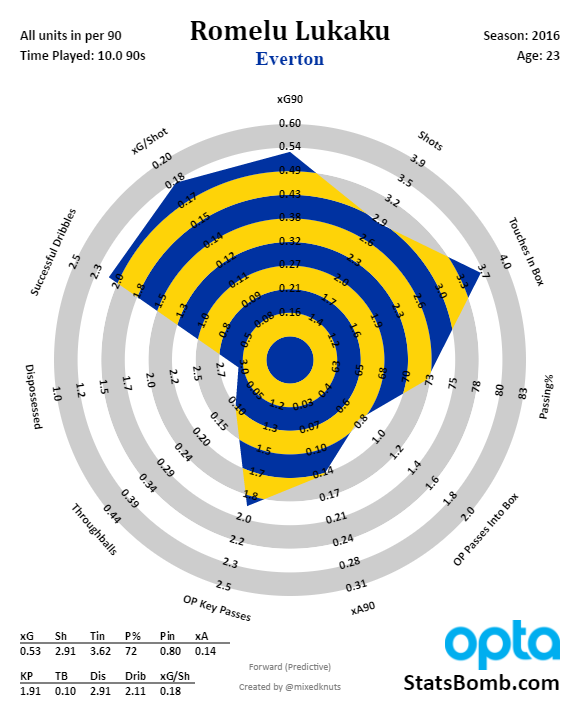
 I wasn't there, but I heard Ian Graham, head of research at Liverpool, did a presentation at a big conference discussing their validation efforts across a wide range of tracking and GPS data, and some companies fared dramatically better than others. This is something that is absolutely necessary to get the most out of data going forward. The problem is that devoting resources to it is not cheap. However, if your organization is up to snuff and cares about these things, validation of current and new equipment should be going on all the time. Whether it actually does...
I wasn't there, but I heard Ian Graham, head of research at Liverpool, did a presentation at a big conference discussing their validation efforts across a wide range of tracking and GPS data, and some companies fared dramatically better than others. This is something that is absolutely necessary to get the most out of data going forward. The problem is that devoting resources to it is not cheap. However, if your organization is up to snuff and cares about these things, validation of current and new equipment should be going on all the time. Whether it actually does...  I am always open to interesting opportunities, and to be honest, the chance to teach and shape future coaches and analysts as part of a broader education program at the country level would be intriguing. At the moment though, I'm enjoying building things related to football but not immersed in the day to day, so I don't feel any pressure to get stuck back in unless it was something really special. Life is good right now. It's also not incredibly stressful. I'm going to keep doing this for a while and see where it goes. We'll cluster the next two together, because they have similar themes
I am always open to interesting opportunities, and to be honest, the chance to teach and shape future coaches and analysts as part of a broader education program at the country level would be intriguing. At the moment though, I'm enjoying building things related to football but not immersed in the day to day, so I don't feel any pressure to get stuck back in unless it was something really special. Life is good right now. It's also not incredibly stressful. I'm going to keep doing this for a while and see where it goes. We'll cluster the next two together, because they have similar themes  It depends on whether you can obtain accurate data or not. If you can, adding a useful tool set on top of that is less than the cost of another performance analyst. If you then bring in someone smart, but young, to help you execute current research and evaluate how well the team is doing, you can probably get a nice boost. My guess is data + tool set + analyst is less than half your average League One player salary. What's interesting is that MLS clubs are starting to invest significantly in this area, and their budgets feel far more constrained than even English League One in some cases. I suspect this is happening because adding stats to sports at this point is a very easy cultural thing to accept in the U.S.
It depends on whether you can obtain accurate data or not. If you can, adding a useful tool set on top of that is less than the cost of another performance analyst. If you then bring in someone smart, but young, to help you execute current research and evaluate how well the team is doing, you can probably get a nice boost. My guess is data + tool set + analyst is less than half your average League One player salary. What's interesting is that MLS clubs are starting to invest significantly in this area, and their budgets feel far more constrained than even English League One in some cases. I suspect this is happening because adding stats to sports at this point is a very easy cultural thing to accept in the U.S.  (Note: This may sound like a sales pitch. It is not. This is my genuine opinion, whether you use StatsBomb Services as the consultancy or someone else.) This is a really interesting question because it hits on a few critical points in the current environment.
(Note: This may sound like a sales pitch. It is not. This is my genuine opinion, whether you use StatsBomb Services as the consultancy or someone else.) This is a really interesting question because it hits on a few critical points in the current environment.  Our numbers have his xG per90 at about .38, so he's good but not amazing. He's a ridiculous athlete though, and that aids everything he does while making him extremely difficult to mark. You're right though, if he had the ball skills of say your typical Spanish player, he'd be unstoppable. As it is, he's getting by on some elite athleticism, but we'll see how long that's sustainable.
Our numbers have his xG per90 at about .38, so he's good but not amazing. He's a ridiculous athlete though, and that aids everything he does while making him extremely difficult to mark. You're right though, if he had the ball skills of say your typical Spanish player, he'd be unstoppable. As it is, he's getting by on some elite athleticism, but we'll see how long that's sustainable.  They are both right now. Their league stats are average, though to be fair they have faced a very difficult schedule thus far. Meanwhile, their style of play is conducive to Champions League style football. Ranieri also has vast experience in the competition (and he's a very good coach), so he's setting them up to succeed without making big mistakes. To be honest, I don't think Leicester really care about the league this year. They won it last year against all odds. This season is about a respectable finish and the best CL run they can possibly make. If those are the goals, the season so far looks just fine.
They are both right now. Their league stats are average, though to be fair they have faced a very difficult schedule thus far. Meanwhile, their style of play is conducive to Champions League style football. Ranieri also has vast experience in the competition (and he's a very good coach), so he's setting them up to succeed without making big mistakes. To be honest, I don't think Leicester really care about the league this year. They won it last year against all odds. This season is about a respectable finish and the best CL run they can possibly make. If those are the goals, the season so far looks just fine.  *tries to figure out a way to answer this that won't get him blackballed from the industry* In five years, Tim will be... *struggling* entertaining(?) fans.... *still struggling* likely as a *whooboy* commentator. *sweating profusely* Yes, I made it! Let me tell you though, his involvement with the rumoured takeover of Swindon by Red Bull is just plain weird. Red Bull have proven extremely competent in their football operations across a number of clubs and countries. Tim Sherwood has been anything but. *looks up* Shit. Time to go. I hope you enjoyed the show, and even if you didn't, you can now rejoice in the fact that we don't have another international break in football until 2017. Peace. --Ted Knutson @mixedknuts
*tries to figure out a way to answer this that won't get him blackballed from the industry* In five years, Tim will be... *struggling* entertaining(?) fans.... *still struggling* likely as a *whooboy* commentator. *sweating profusely* Yes, I made it! Let me tell you though, his involvement with the rumoured takeover of Swindon by Red Bull is just plain weird. Red Bull have proven extremely competent in their football operations across a number of clubs and countries. Tim Sherwood has been anything but. *looks up* Shit. Time to go. I hope you enjoyed the show, and even if you didn't, you can now rejoice in the fact that we don't have another international break in football until 2017. Peace. --Ted Knutson @mixedknuts 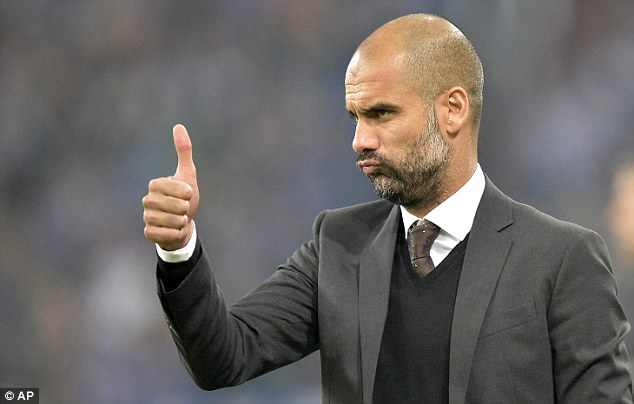
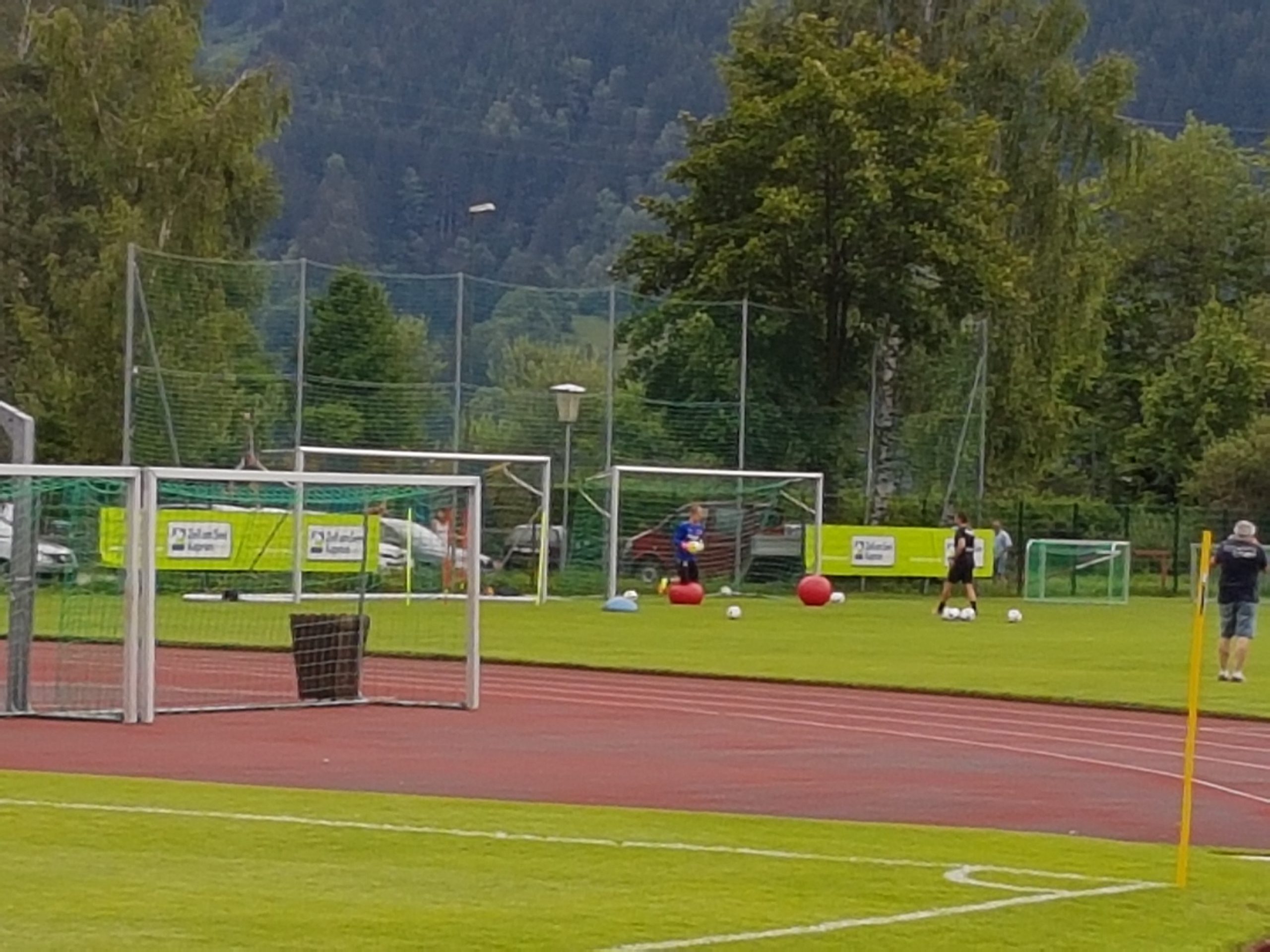
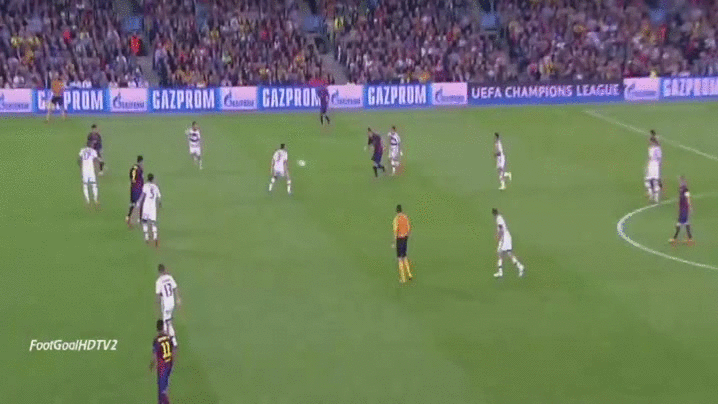
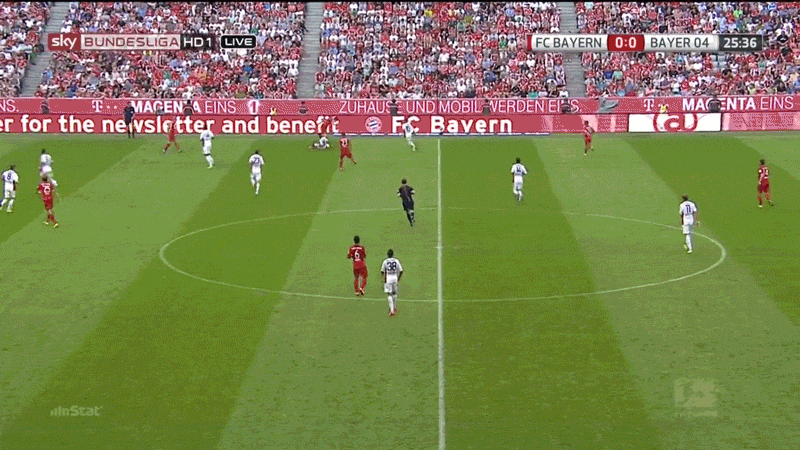
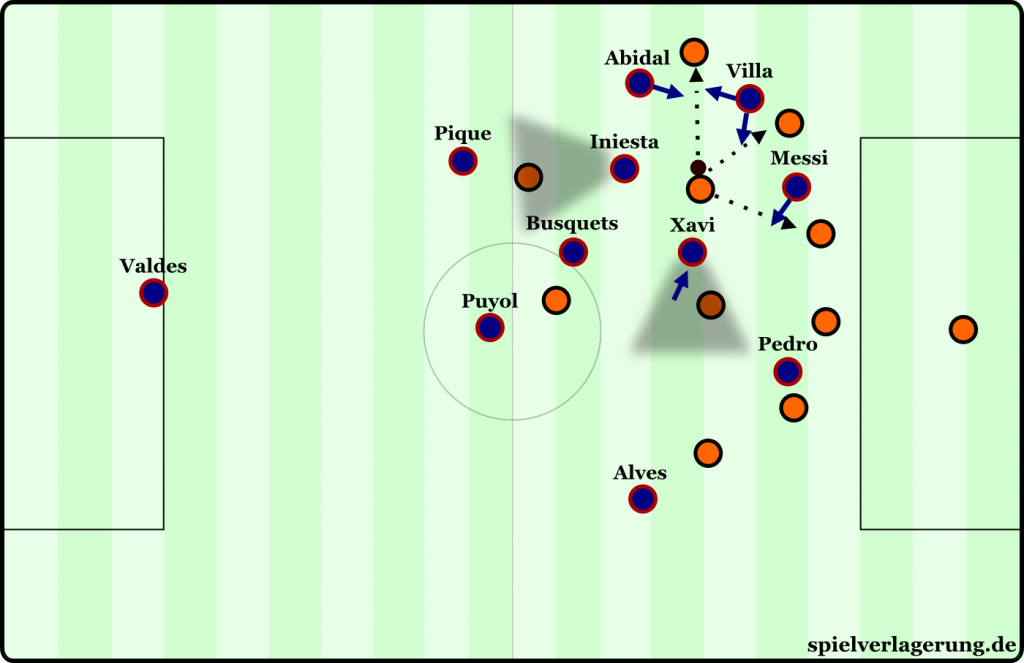
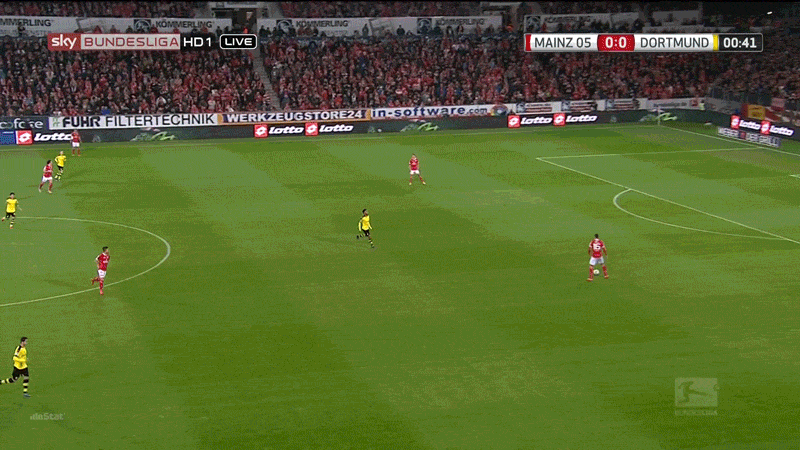
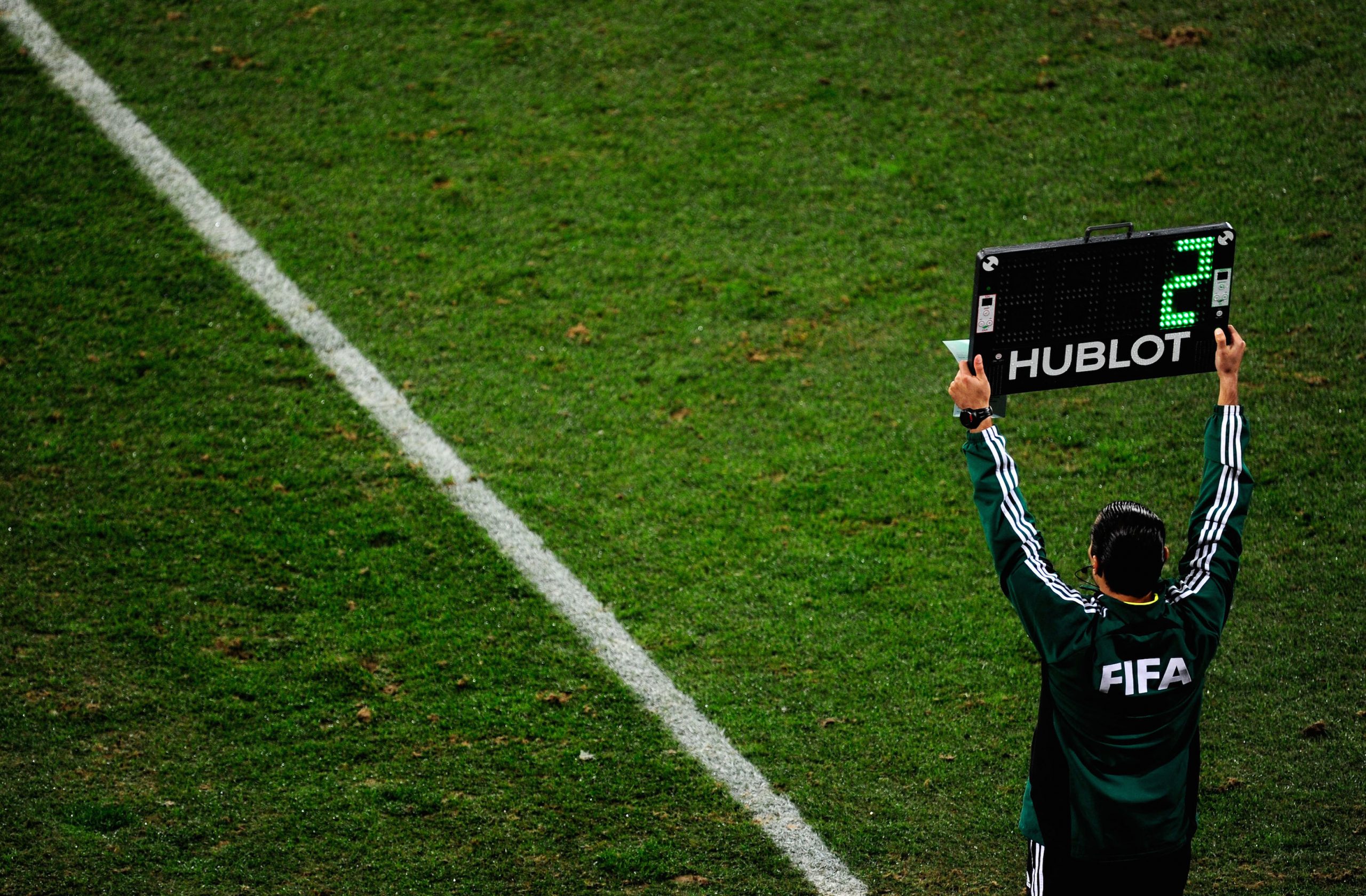
 The data for this study comes from the 2014-15 French season. It's the only place and year I had game-state data for all the passes. Possession Trailing teams possess the ball more. In this specific season we are looking at, trailing teams played 53% of the passes while leading teams played 47% of the passes. Unsurprisingly, this isn't because low-possession teams take the lead more often, it's because teams change their behavior after a score change: 15 teams increased their possession share when going behind while only 4 increased it when taking the lead. Starting at the Back: Long Balls When Ahead When teams go ahead, they start hitting a lot more long balls. Every single team in the study hit more long balls from zone 7 when leading compared to when tied. 17 of the 20 teams hit fewer long balls when losing compared to tied.
The data for this study comes from the 2014-15 French season. It's the only place and year I had game-state data for all the passes. Possession Trailing teams possess the ball more. In this specific season we are looking at, trailing teams played 53% of the passes while leading teams played 47% of the passes. Unsurprisingly, this isn't because low-possession teams take the lead more often, it's because teams change their behavior after a score change: 15 teams increased their possession share when going behind while only 4 increased it when taking the lead. Starting at the Back: Long Balls When Ahead When teams go ahead, they start hitting a lot more long balls. Every single team in the study hit more long balls from zone 7 when leading compared to when tied. 17 of the 20 teams hit fewer long balls when losing compared to tied. 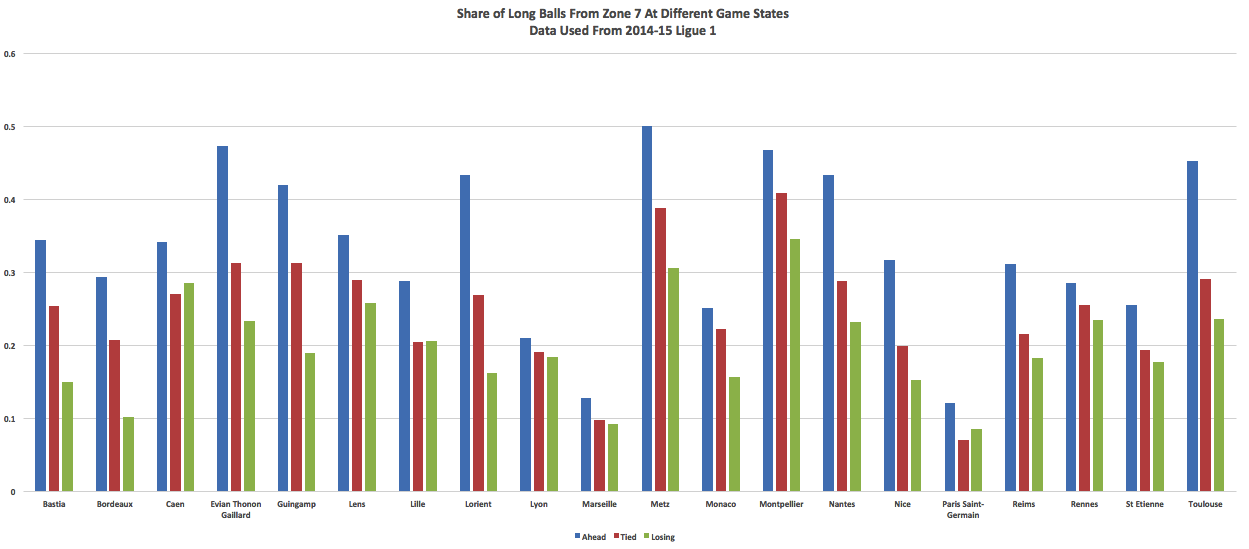 Field Tilt: Score or Time A Bigger Factor? Field tilt here is measuring the share of completions in zones 1 and 2, so the more time spent in front of goal the higher the field tilt. I was not surprised to find that losing teams have a higher share of their completions in advanced positions: teams average a 20% increase of the share of completions in zones 1 or 2 compared to tie games. I was kind of surprised to see winning teams see a 12% increase as well.
Field Tilt: Score or Time A Bigger Factor? Field tilt here is measuring the share of completions in zones 1 and 2, so the more time spent in front of goal the higher the field tilt. I was not surprised to find that losing teams have a higher share of their completions in advanced positions: teams average a 20% increase of the share of completions in zones 1 or 2 compared to tie games. I was kind of surprised to see winning teams see a 12% increase as well. 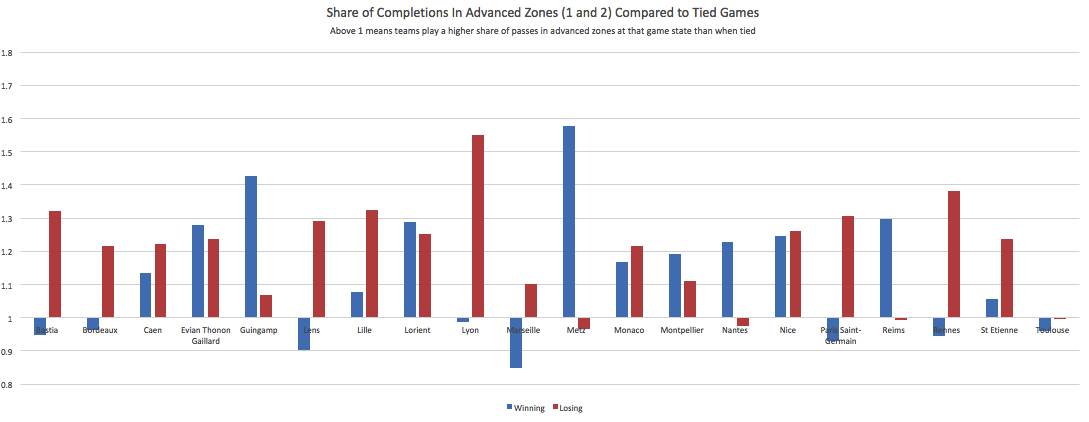 I can intuitively write an explanation backwards around that data (something like: When a team has a lead, games tend to see a lot more of the action played around the goalmouth as trailing teams push forward allowing for quick counters from the losing side), which I was ready to do until I looked at the time factor.
I can intuitively write an explanation backwards around that data (something like: When a team has a lead, games tend to see a lot more of the action played around the goalmouth as trailing teams push forward allowing for quick counters from the losing side), which I was ready to do until I looked at the time factor. 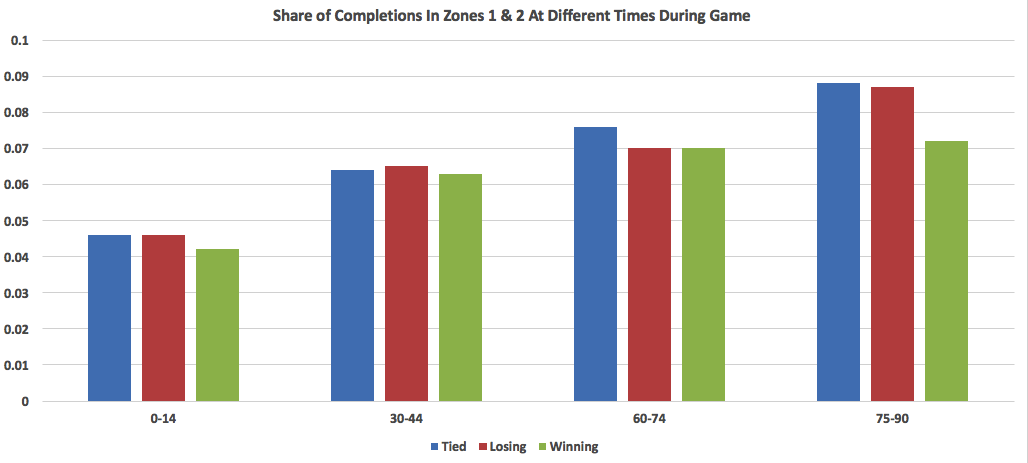 So this changes things. Whether your team is winning, tied or losing only makes a small difference until the final minutes but all 3 trend up nearly in lockstep as the game progresses. Whether this is a reflection of game theory where coaches and players purposefully play cautious early on or a reflection of fatigue can't be determined. Putting on my pundit-hat (and we've seen in recent days that broad, sweeping conclusions from data journalist types based on small bits of data generally do not lead anyone wrong) I suspect it's more of the first and less (though still some) of the second. Up Front: Entering Zone 2 from Zone 3 This was surprising. While the league as a whole had a significantly higher completion % while winning (which is what I expected), only 11 of 20 teams actually had a higher completion % when leading compared to tied. 12 of 20 actually had a higher completion % while losing. This tells me that the difference in total comes from PSG and Lyon leading the most and being the best at this category. Game state itself doesn't seem to be a pushing factor here, passes entering the danger zone are generally completed at a similarly slightly higher rate when losing or ahead compared to a tie.
So this changes things. Whether your team is winning, tied or losing only makes a small difference until the final minutes but all 3 trend up nearly in lockstep as the game progresses. Whether this is a reflection of game theory where coaches and players purposefully play cautious early on or a reflection of fatigue can't be determined. Putting on my pundit-hat (and we've seen in recent days that broad, sweeping conclusions from data journalist types based on small bits of data generally do not lead anyone wrong) I suspect it's more of the first and less (though still some) of the second. Up Front: Entering Zone 2 from Zone 3 This was surprising. While the league as a whole had a significantly higher completion % while winning (which is what I expected), only 11 of 20 teams actually had a higher completion % when leading compared to tied. 12 of 20 actually had a higher completion % while losing. This tells me that the difference in total comes from PSG and Lyon leading the most and being the best at this category. Game state itself doesn't seem to be a pushing factor here, passes entering the danger zone are generally completed at a similarly slightly higher rate when losing or ahead compared to a tie.  Overall Totals here:
Overall Totals here: 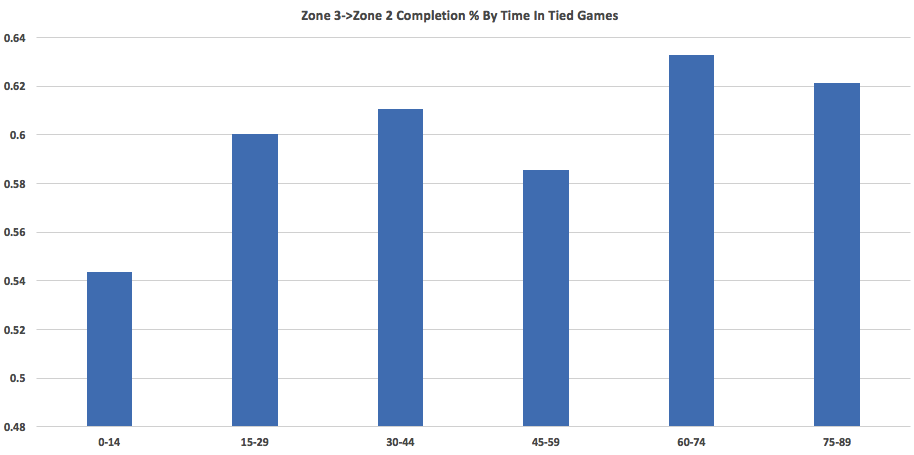 In the second half you can see a sort of "reset" as the completion % on these entry drops to start the half though not close to the start of the game. Then it quickly rises again throughout the second half. Conclusions And Further Questions
In the second half you can see a sort of "reset" as the completion % on these entry drops to start the half though not close to the start of the game. Then it quickly rises again throughout the second half. Conclusions And Further Questions 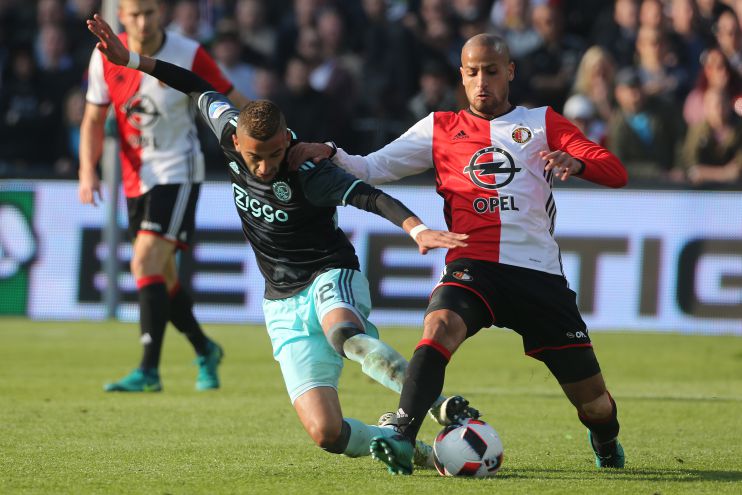
 Feyenoord The last time Feyenoord won the Eredivisie, 14 players in Feyenoord’s current first team squad were not even in primary school yet and Dirk Kuijt had just burst onto the scene with Utrecht. It’s fair to say that a season where they put in a serious title challenge has been a long time coming for the Pride of the South. The defence has seen van der Heijden, Botteghin and Kongolo cover reasonably well despite the fact that the former two have the combined pace of a lazy cat. Feyenoord have the lowest shot ratio (62.5%), and expected goals suggest they have been lucky not to concede more, while they allow more shots on goal than the other two contenders. It’s further ahead that things have gone well for Feyenoord this season. The midfield triumvirate of Karim El Ahmadi, Tonny Vilhena and Dirk Kuijt have shown a great deal of efficacy in doing simple things – and while they don’t play ‘Cruijffian’ football, this was one of Cruijff’s most famous sayings, that playing simple football could often be difficult. El Ahmadi and Vilhena have shielded the defence well while forming a passing axis with the two fullbacks and Toornstra. Feyenoord, as a team, have only had a cumulative 11 unsuccessful touches per game too, the least in the league, so they’ve been pretty well-drilled in their passing movements by van Bronckhorst and van Gastel. It is not much of a coincidence that Feyenoord’s first defeat of the season was dealt when both El Ahmadi and Vilhena were missing from the XI. Dirk Kuijt, on the other hand, is partially a beneficiary of the Wayne Rooney paradox. There are games where he can be relatively invisible and ineffectual but he is the club captain and he often seems to be the most likely to get a ‘clutch’ goal. I think it is pretty unlikely Kuijt will get the Rooney treatment and be benched soon though. His energy fits well with the profile of players around him and allows Toornstra some more freedom to wander around and provide a creative contribution. 41% of Feyenoord’s attacks come down the right flank, which is testament to the fact that Karsdorp has continued providing a vital wide option on the right while combining well with summer acquisition Steven Berghuis (or Bae-rghuis, according to Ted) as well as Bilal Basacikoglu in recent outings, although Berghuis still fails to impress as he did with AZ. Feyenoord’s attack is where the difference is really palpable between recent seasons and this season. Despite having inferior expected goal and shot ratios to PSV and Ajax, they are being powered in part by a SoT/Goal of 35%. Nicolai Jorgensen has been a real upgrade over Michiel Kramer and has hit the ground running in the Eredivisie, since arriving from Denmark in the summer. Taking 4.1 non-penalty shots per 90 with a conversion of 19% has seen him top the league’s scoring charts. Important too is that the Dane plays 17.3 accurate short passes p90, compared to the 10.6 of Kramer last season. This adds some more coherence to Feyenoord’s attack; the presence of that extra option to pass to lets his teammates act a bit quicker and the team’s speed of moving the ball increases. This is particularly helpful in the final third and most of Feyenoord’s attacks have been results of swift circulation in that part of the field. Feyenoord's last three matches have resulted in a loss and two draws and it may end up that their early 'luck' has run its course, as it often ends up doing around halfway through seasons, whenever they have threatened to be title contenders. Ajax A shaky start to the season had people calling for Peter Bosz’s head before he’d even managed to construct a team in his semblance. Ajax’s u-turn on Ziyech is at the moment, pretty undoubtedly the pivotal point that has turned Ajax’s fortunes around.
Feyenoord The last time Feyenoord won the Eredivisie, 14 players in Feyenoord’s current first team squad were not even in primary school yet and Dirk Kuijt had just burst onto the scene with Utrecht. It’s fair to say that a season where they put in a serious title challenge has been a long time coming for the Pride of the South. The defence has seen van der Heijden, Botteghin and Kongolo cover reasonably well despite the fact that the former two have the combined pace of a lazy cat. Feyenoord have the lowest shot ratio (62.5%), and expected goals suggest they have been lucky not to concede more, while they allow more shots on goal than the other two contenders. It’s further ahead that things have gone well for Feyenoord this season. The midfield triumvirate of Karim El Ahmadi, Tonny Vilhena and Dirk Kuijt have shown a great deal of efficacy in doing simple things – and while they don’t play ‘Cruijffian’ football, this was one of Cruijff’s most famous sayings, that playing simple football could often be difficult. El Ahmadi and Vilhena have shielded the defence well while forming a passing axis with the two fullbacks and Toornstra. Feyenoord, as a team, have only had a cumulative 11 unsuccessful touches per game too, the least in the league, so they’ve been pretty well-drilled in their passing movements by van Bronckhorst and van Gastel. It is not much of a coincidence that Feyenoord’s first defeat of the season was dealt when both El Ahmadi and Vilhena were missing from the XI. Dirk Kuijt, on the other hand, is partially a beneficiary of the Wayne Rooney paradox. There are games where he can be relatively invisible and ineffectual but he is the club captain and he often seems to be the most likely to get a ‘clutch’ goal. I think it is pretty unlikely Kuijt will get the Rooney treatment and be benched soon though. His energy fits well with the profile of players around him and allows Toornstra some more freedom to wander around and provide a creative contribution. 41% of Feyenoord’s attacks come down the right flank, which is testament to the fact that Karsdorp has continued providing a vital wide option on the right while combining well with summer acquisition Steven Berghuis (or Bae-rghuis, according to Ted) as well as Bilal Basacikoglu in recent outings, although Berghuis still fails to impress as he did with AZ. Feyenoord’s attack is where the difference is really palpable between recent seasons and this season. Despite having inferior expected goal and shot ratios to PSV and Ajax, they are being powered in part by a SoT/Goal of 35%. Nicolai Jorgensen has been a real upgrade over Michiel Kramer and has hit the ground running in the Eredivisie, since arriving from Denmark in the summer. Taking 4.1 non-penalty shots per 90 with a conversion of 19% has seen him top the league’s scoring charts. Important too is that the Dane plays 17.3 accurate short passes p90, compared to the 10.6 of Kramer last season. This adds some more coherence to Feyenoord’s attack; the presence of that extra option to pass to lets his teammates act a bit quicker and the team’s speed of moving the ball increases. This is particularly helpful in the final third and most of Feyenoord’s attacks have been results of swift circulation in that part of the field. Feyenoord's last three matches have resulted in a loss and two draws and it may end up that their early 'luck' has run its course, as it often ends up doing around halfway through seasons, whenever they have threatened to be title contenders. Ajax A shaky start to the season had people calling for Peter Bosz’s head before he’d even managed to construct a team in his semblance. Ajax’s u-turn on Ziyech is at the moment, pretty undoubtedly the pivotal point that has turned Ajax’s fortunes around. 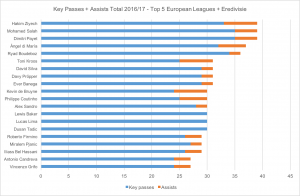 Barring the draw with Feyenoord, Ajax’s ExpG per match post-Ziyech has been higher and much more favourable compared to pre-Ziyech, even more so after he was reinstated in the #10 position, as opposed to the right wing. Ziyech is a ball-magnet for Ajax in possession and moves across the frontline to receive the ball and find an outlet. As such, Ajax use slightly more of the middle of the pitch in attack (29%) compared to last year (26%), when the play was excessively dependent on wide service. Ziyech is also keeping up a healthy number of key passes p90 (3.8) which is much more than the numbers he has put up over the last few years. While I do expect this will go down a bit over the course of the season, it’s almost 1 key pass more per game than last season, which is indicative of how he’s managed to maintain and improve on his attacking ability despite being in a new team, having to put in more off-the-ball work and against defences that play tighter and deeper than he was used to, with Twente. Bosz’s general philosophy is starting to become more apparent in an effective way too, since Ajax play higher up the field now than under Frank de Boer and 33% of their possession happens in the opponent’s final third. Schone’s role in defensive midfield has reduced some of the dilly-dallying on the ball that was prevalent in the middle-third. Ajax are pretty neck to neck with PSV in terms of shots but they’re scoring a lot more from their chances, which is partly the increase in quality of chances created in recent weeks and the fact that the likes of Klaassen, Dolberg and Traore are all sharing the goalscoring burden pretty well. At the back, an unlikely central pairing in Sanchez-Viergever have held fort relatively well but the right flank with Veltman and Traore remains more liable, which is surprising considering an attacking midfielder is playing fullback on the other side. Sinkgraven has taken admirably to the leftback role and his links to Ziyech coming in off the left-side of midfield as well as Klaassen and Schone in the centre help Ajax move ahead effectively on pitch. The off-pitch fracas surrounding Gudelj and El Ghazi has been less palatable but there is little doubt that their exclusion has come for the better of the team and Bosz has been justified in his selection choices in as much. European performances have been more encouraging this season too. Ajax seem a little less shackled by dogma and a little more open to switching their mode of attack. The unpredictability of Ziyech and Dolberg has helped in this regard too, since you need individual moments of excellence to get you through some tough matches. PSV Dear, oh dear. Things have gone a bit gloomy in Eindhoven this season. The most baffling thing is that PSV continue to post some of the best numbers in the league (and Europe). They’ve conceded the least number of shots (79) and average the most shots inside the box pg (12.6), and have the highest TSR (72.9%). And yet, they have drawn 3 of their last 5 league games, have gone out of the Cup and likely out of the Champions League in recent weeks and seem a shadow of their former selves, to borrow a cliché.
Barring the draw with Feyenoord, Ajax’s ExpG per match post-Ziyech has been higher and much more favourable compared to pre-Ziyech, even more so after he was reinstated in the #10 position, as opposed to the right wing. Ziyech is a ball-magnet for Ajax in possession and moves across the frontline to receive the ball and find an outlet. As such, Ajax use slightly more of the middle of the pitch in attack (29%) compared to last year (26%), when the play was excessively dependent on wide service. Ziyech is also keeping up a healthy number of key passes p90 (3.8) which is much more than the numbers he has put up over the last few years. While I do expect this will go down a bit over the course of the season, it’s almost 1 key pass more per game than last season, which is indicative of how he’s managed to maintain and improve on his attacking ability despite being in a new team, having to put in more off-the-ball work and against defences that play tighter and deeper than he was used to, with Twente. Bosz’s general philosophy is starting to become more apparent in an effective way too, since Ajax play higher up the field now than under Frank de Boer and 33% of their possession happens in the opponent’s final third. Schone’s role in defensive midfield has reduced some of the dilly-dallying on the ball that was prevalent in the middle-third. Ajax are pretty neck to neck with PSV in terms of shots but they’re scoring a lot more from their chances, which is partly the increase in quality of chances created in recent weeks and the fact that the likes of Klaassen, Dolberg and Traore are all sharing the goalscoring burden pretty well. At the back, an unlikely central pairing in Sanchez-Viergever have held fort relatively well but the right flank with Veltman and Traore remains more liable, which is surprising considering an attacking midfielder is playing fullback on the other side. Sinkgraven has taken admirably to the leftback role and his links to Ziyech coming in off the left-side of midfield as well as Klaassen and Schone in the centre help Ajax move ahead effectively on pitch. The off-pitch fracas surrounding Gudelj and El Ghazi has been less palatable but there is little doubt that their exclusion has come for the better of the team and Bosz has been justified in his selection choices in as much. European performances have been more encouraging this season too. Ajax seem a little less shackled by dogma and a little more open to switching their mode of attack. The unpredictability of Ziyech and Dolberg has helped in this regard too, since you need individual moments of excellence to get you through some tough matches. PSV Dear, oh dear. Things have gone a bit gloomy in Eindhoven this season. The most baffling thing is that PSV continue to post some of the best numbers in the league (and Europe). They’ve conceded the least number of shots (79) and average the most shots inside the box pg (12.6), and have the highest TSR (72.9%). And yet, they have drawn 3 of their last 5 league games, have gone out of the Cup and likely out of the Champions League in recent weeks and seem a shadow of their former selves, to borrow a cliché. 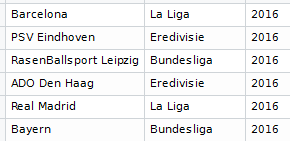
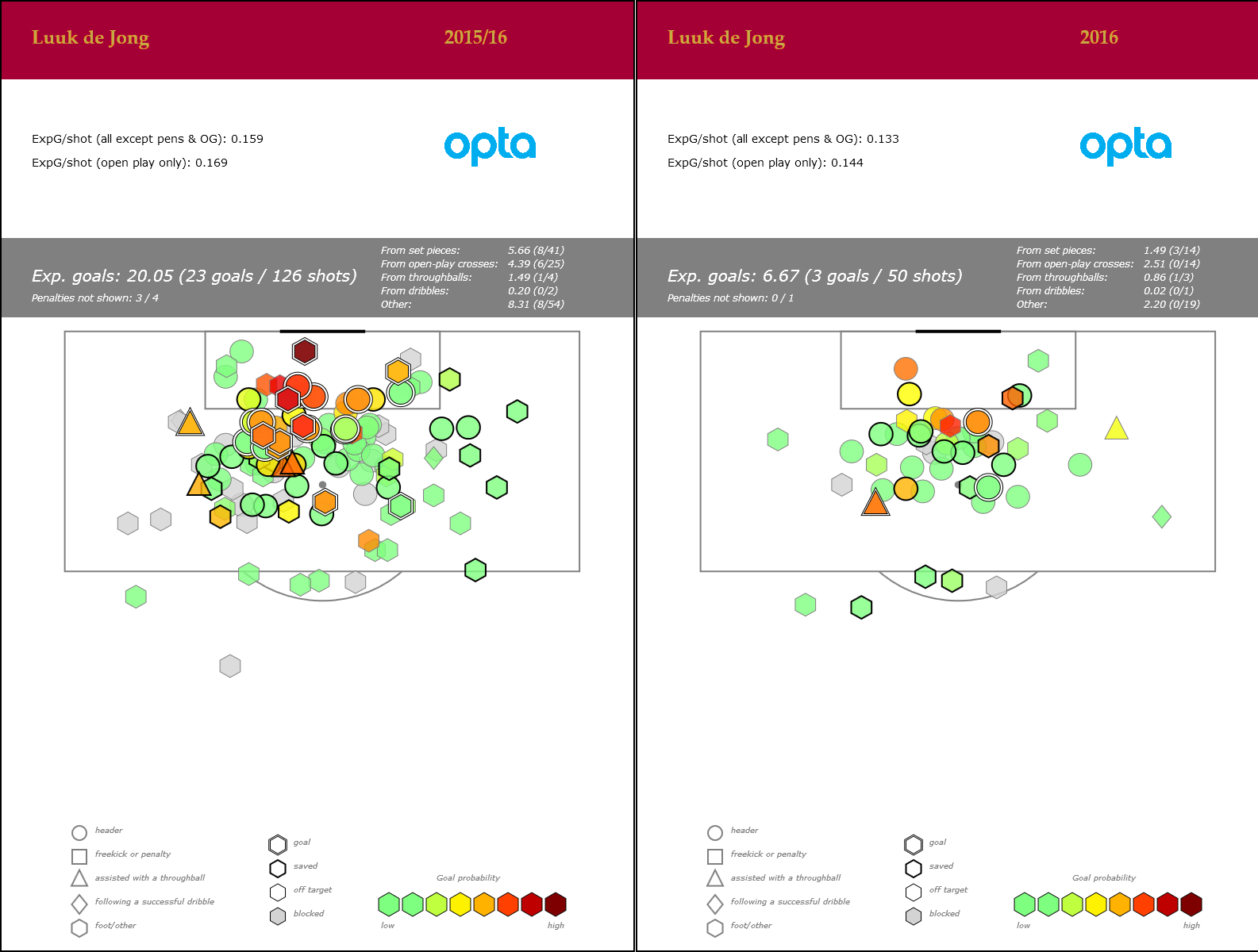 In a way, PSV resemble Ajax in the last two years of the Frank de Boer era – devoid of a proper Plan B when their Plan A is stifled by opponents. For example, in the 0-0 vs Groningen, PSV attempted 60(!) crosses, and Groningen made 63 clearances from inside their box. There was a certain pattern to the that emerged that
In a way, PSV resemble Ajax in the last two years of the Frank de Boer era – devoid of a proper Plan B when their Plan A is stifled by opponents. For example, in the 0-0 vs Groningen, PSV attempted 60(!) crosses, and Groningen made 63 clearances from inside their box. There was a certain pattern to the that emerged that 
